

The United States SPECIALIST
for the Collector of Postage & Revenue Stamp Issues of the United States
WHOLE NUMBER 1149
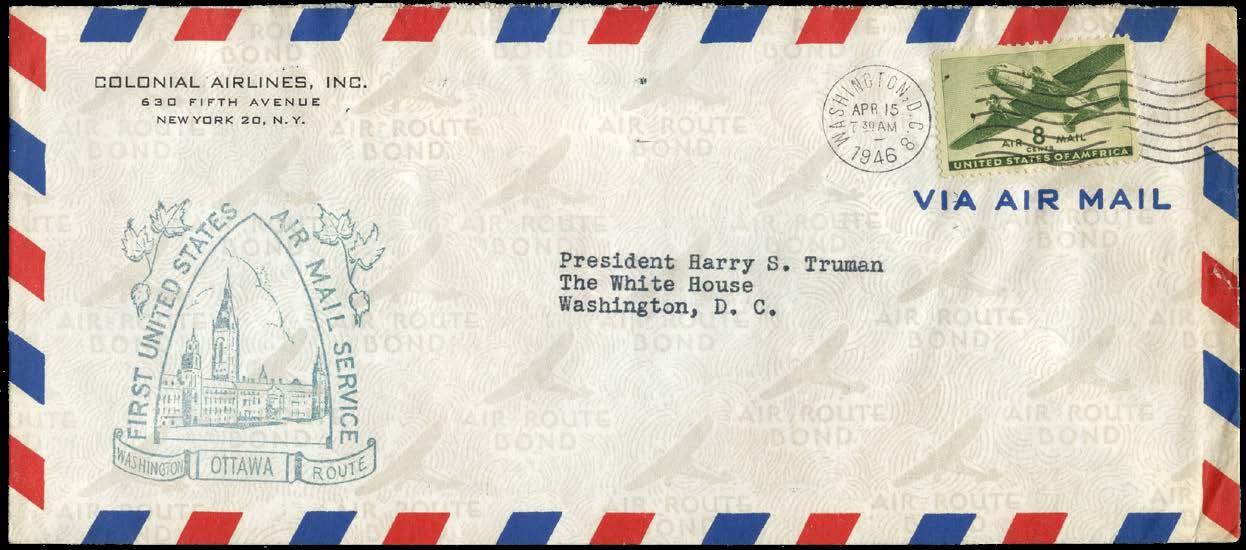
President Harry S. Truman and Transport Airmail Stamps
s plus e

The Great Americans Issue
By the Numbers
c and j
Government Coil Stamp Supply and Demand, Part I, Kaolin Content Trends in Postage Stamp Paper, Part III, & more.
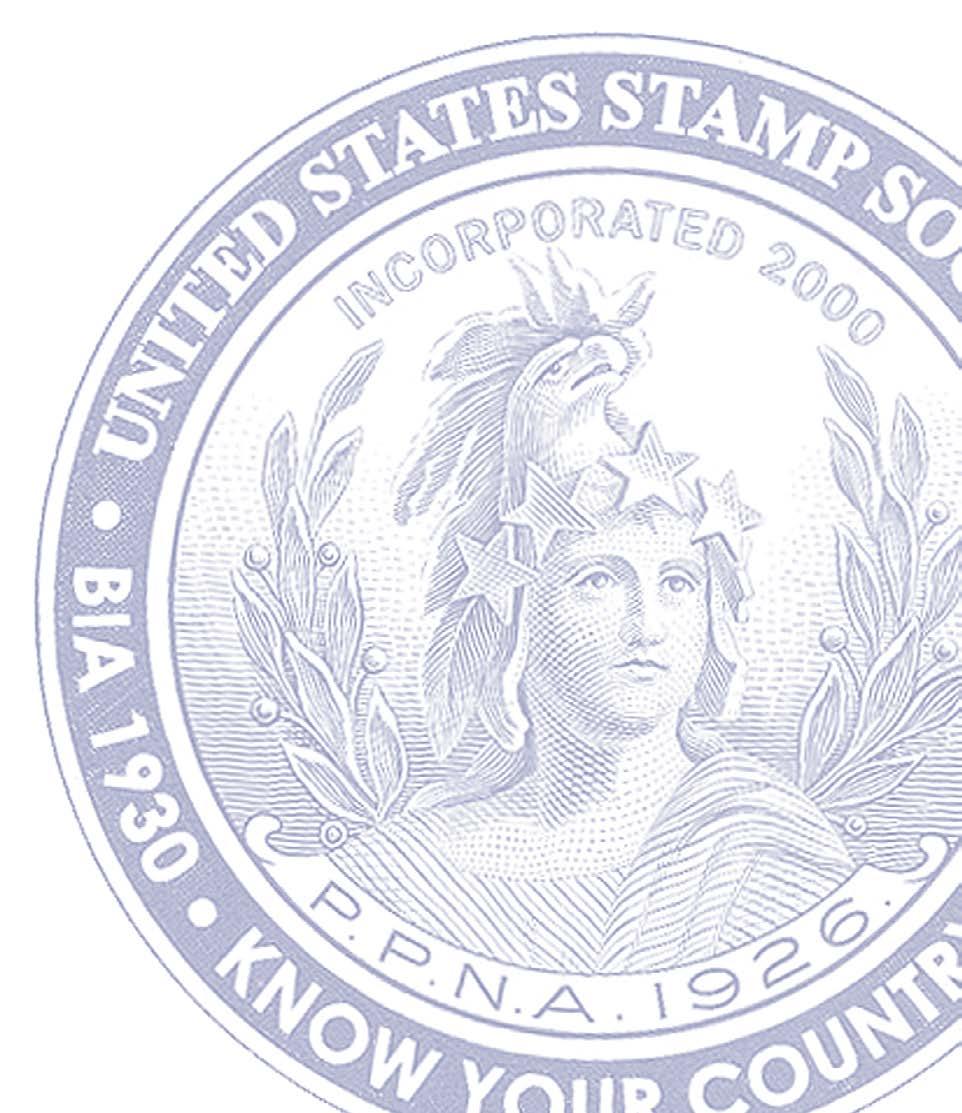

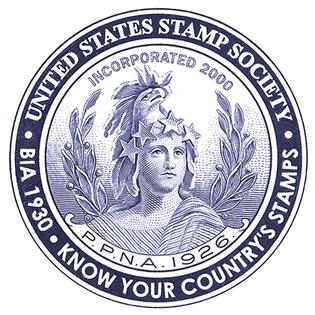

Encyclopedia of United States Stamps and Stamp Collecting Second Edition
Edited by Rodney A. Juell, Lynn R. Batdorf and Steven J. Rod
Hardbound, 769 pages. $35 members, $40 nonmembers. Visit the website for shipping costs.
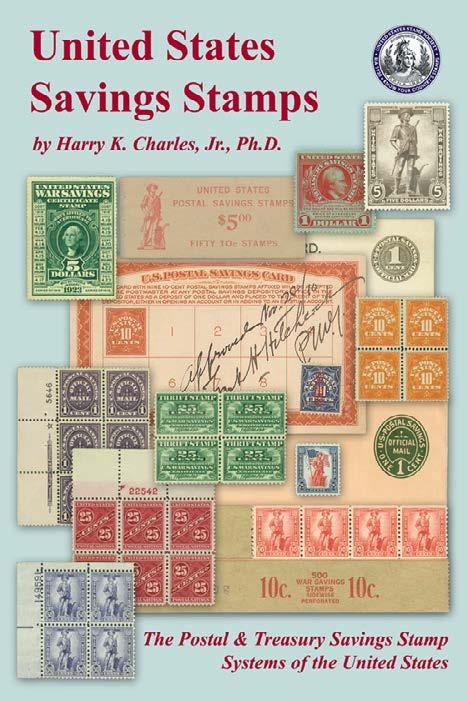
United States Savings Stamps by Harry K. Charles, Jr.
A presentation of the United States Postal and Treasury Savings Stamp Systems, the stamps and their closely associated collection cards and booklets, and Official Mail stamps and stationery.
Softbound, 253 pages.
Postpaid: $25 members, $28 nonmembers. Visit the website for shipping costs.
Order from: USSS, P.O. Box 1602, Hockessin, DE 19707-5602 or online at: www.usstamps.org/store/

VOLUME 96, NUMBER 11
The United States SPECIALIST
the journal of the United States Stamp Society
N OVEMBER 2025
WHOLE NUMBER 1149
An association of collectors to promote the study of all postage and revenue stamps and stamped paper of the United States and US-administered areas produced by the Bureau of Engraving and Printing and other contract printers. American Philatelic Society Affiliate No. 150
Prologue
504 Vintage Photo of the Month by Rodney A. Juell

Epilogue
525 Executive Secretary’s Report by Robert Rufe 526 Plate Number Report by Kim D. Johnson
528 Classified Advertising 528 Index of Advertisers
Andrew S. Kelley, Editor 9038 East 25th Drive Denver, CO 80238
email: editor@usstamps.org
www.usstamps.org
Manuscripts, publications for review, and all advertising including classifieds, should be sent to the Editor at the address above.
Forms close on the 20th of the second month preceding the month of publication, as February 20 for the April edition.
The United States Specialist (ISSN 0164-923X) is published monthly January through December by the United States Stamp Society, Inc., P.O. Box 1602,
Features
484 Government Coil Stamp Supply and Demand: BEP Fiscal Years 1908 through 1925. Part I: Overview and Flat-Plate Era; FY 1908–1914 by Nancy Robinson, PhD and James Robinson
497 President Harry S. Truman and Transport Airmail Stamps by Paul M. Holland
506 Great Americans Issue XVIII— By the Numbers by Jay Stotts

510 The Coming and Going of China Clay in BEP Printing Paper. Part III: Kaolin Content Trends in the Paper Used to Print Regular Issue, Commemorative, and Airmail Stamps Between 1935 and 1955 by Harry G. Brittain, PhD
Hockessin, DE 19707-5602. Membership in the United States $25. North America $40; all others $65. Single copy $2. Periodical postage paid at Hockessin, DE, and at additional entry offices. Printed in USA.
Copyright ©2025 United States Stamp Society, Inc. All rights reserved. Opinions expressed by authors are their own and do not necessarily reflect those of the United States Stamp Society, its officers, or staff.
Correspondence concerning business affairs of the Society, including membership and changes in address, should be addressed to the Executive Secretary, PO Box 1602, Hockessin, DE 19707-5602.
Postmaster: Send address changes to U.S.S.S., P.O. Box 1602, Hockessin, DE 19707-5602.
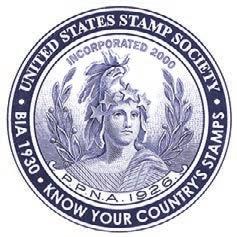
The United States Specialist
Founded 1930 as The Bureau Specialist
EDITOR
ANDREW S. KELLEY
9038 East 25th Drive Denver, CO 80238 email: editor@usstamps.org
United States Stamp Society Bureau Issues Association, Inc.
P.O. Box 1602 Hockessin, DE 19707-5602
CHAIRMAN
Roger S. Brody
P.O. Box 5836 Somerset, NJ 08875-5836 email: brody@usstamps.org
PRESIDENT
Nicholas Lombardi
P.O. Box 1005 Mountainside, NJ 07092 email: 8605@comcast.net
VICE PRESIDENT
Jeffrey Shapiro
P.O. Box 3211 Fayville, MA 01745-3211 email: coverlover@gmail.com
SECRETARY
Joel Cohen
10703 Kings Riding Way, Unit T-1 Rockville, MD 20852-5420 email: cohenji@comcast.net
TREASURER
David S. Sugar 4045 N. Harvard Ave. Arlington Heights, IL 60004 email: david-sugar@wsdd.com
GOVERNORS
Lynn Batdorf
Kim Johnson
Mike Lampson
Leonard Piszkiewicz
James Robinson
Robert Rose
Rod Juell
Gregory Shoults
David Steidley
Jay Stotts
Steven Unkrich
EXECUTIVE
SECRETARY
Robert Rufe
P.O. Box 1602
Hockessin, DE 19707-5602 email: execsecretary@usstamps.org
— Committees — AWARDS
Denise Stotts
email: stottsjd@swbell.net
BOOKLETS & BOOKLET PANES
Michael O. Perry
P.O. Box 1194, Rainier, OR 97048 email: MOPerry@mac.com
DURLAND EDITOR
Kim D. Johnson
310 E N 3rd Street, Georgetown, IL 61846 email: westhome1@aol.com
ESSAY-PROOF
James Patterson
1850 North Central Avenue, No. 1400 Phoenix, AZ 85004
email: jhpatterson@yahoo.com
EXHIBIT PDFs
Chris Steenerson
P.O. Box 1818
Westminster, CO 80038-1818
email: Chris@RxStamps.com
FARLEY ERA
Paul M. Holland
email: pholland.thorleaf@gmail.com
FOURTH BUREAU ISSUE
Jay B. Stotts email: stottsjd@swbell.net
LIBERTY SERIES
Roland Austin P.O. Box 2641, Stillwater, OK 74076-2641 email: RAustin13@aol.com
MARGINAL MARKINGS
Chris Steenerson
P.O. Box 1818 Westminster, CO 80038-1818 email: Chris@RxStamps.com
MODERN POSTAL HISTORY
Douglas B. Quine 59 Taylor Rd., Bethel CT 06801 email: usss2010@quine.org
PLATE NUMBER & CHECKLIST SERVICE
Kim D. Johnson
310 E N 3rd Street, Georgetown, IL 61846 email: westhome1@aol.com
PRECANCELS
Lynn R. Batdorf 6005 Kingsford Road, Bethesda, MD 20817 email: hollykids@comcast.net
PRESIDENTIAL ERA
Jeffrey Shapiro P.O. Box 3211, Fayville, MA 01745-3211
RECRUITING
Steven Crippe PO Box 117001, Carrollton, TX 75011 email: scrippe@gmail.com
REVENUE ISSUES
Peter Martin P.O. Box 6074, Fredericksburg, VA 22403 email: pmartin2525@yahoo.com
SECOND BUREAU ISSUE
Nicholas Lombardi P.O. Box 1005, Mountainside, NJ 07092
VENDING AND AFFIXING MACHINE PERFORATIONS
Dan Ryterband 40 Carolyn Place, Chappaqua, NY 10514 email: djryterband@fwcook.com
WASHINGTON-FRANKLIN
HEAD ISSUES (Co-Chairmen)
Greg Shoults 11248 Frederick Lane Twinsburg, OH 44087 email: coilcollector@hotmail.com
Andrew S. Kelley 9038 East 25th Dr, Denver, CO 80238 email: stamps@andrewkelley.net
WEBMASTER
Mike Lampson
P.O. Box 471963, Charlotte, NC 28247 email: lampson@usstamps.org
— Study Groups — DUMMY STAMPS
Terry R. Scott
P.O. Box 10406, Napa, CA 94581 email: terryrscott@comcast.net
FIRST BUREAU ISSUE [open]
LUMINESCENCE
Wayne L. Youngblood 705 Forest Glen Circle, Prairie du Sac WI 53578
email: wystamps@gmail.com
OVERRUN COUNTRIES SERIES
Thomas Schilling
P.O. Box 432, New Lisbon, NJ 08064-0432 email: cbtkschilling@yahoo.com
PROMINENT AMERICANS AND AMERICANA SERIES
Ron Blanks
P.O. Box 9282, Chesapeake VA 23321 email: rblanks_stamps@yahoo.com
REGISTERED MAIL
Mike Ludeman
P.O. Box 2024, Denton, Texas 76202-2024 email: mike@ludeman.net
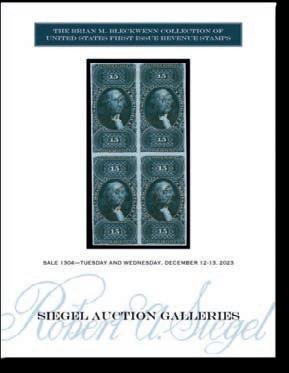
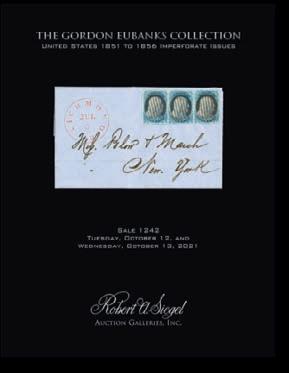
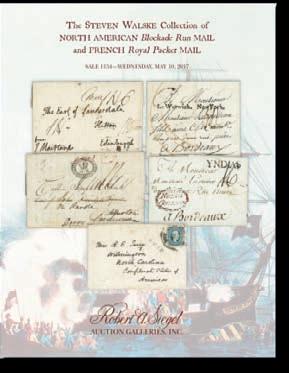

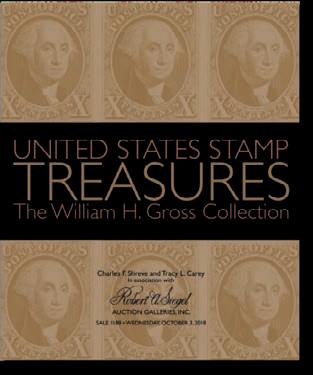
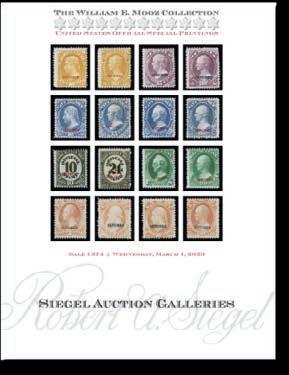
Siegel offers unparalleled expertise, a worldwide client base, financial reliability, intelligent marketing, and the best internet resources of any philatelic auction house. Contact us today to learn more about consigning with Siegel and ensuring your legacy.

21 West 38th Street, 7th Floor
Phone (212) 753-6421
Email: stamps@siegelauctions.com
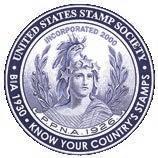
Coil Stamps
Government Coil Stamp Supply and Demand: BEP Fiscal Years
1908 through 1925
Part I: Overview and Flat-Plate Era; FY 1908–1914
by Nancy Robinson, P h D and James Robinson USSS
# 12386 (James Robinson) | m
jsr.new2019@gmail.com
Introduction
Government coils were first issued in February 1908. They were supplied either perforate (perforated 12) or imperforate in both end (perforated horizontally) and side (perforated vertically) coil format. In this series of articles, coil delivery information provided in the Bureau of Engraving and Printing (BEP) and Post Office Department (POD) annual reports and plate print records is analyzed. The analysis reveals new insights and confirms or refutes previous authors’ statements concerning coil stamp supply and demand from fiscal year (FY) 1908 to 1925. The following bulleted list highlights the major findings in this four-part series:
Part I
• The year-to-year increase in coil demand can be modeled as a line whose slope is an additional 200,000,000 coil stamps per year.
• The high-demand denominations (3¢ coils in FY 1918–1919 and the 1¢, 2¢ and 1½¢ coils for the entire period) make up 98.8% of the coil stamps delivered to the POD.
• Quantities of coils of 500 and 1,000 for each denomination are derived. 500length coils represent 86% of the total coils delivered in FY 1910 through FY 1923.
• Coils were not delivered solely in “box quantities” of 5 or 50.
• For FY 1910 through 1912, the percentage of total coils delivered in the perforated versus unperforated format was 58%, 42%, and 69%, respectively.
Part II
• No rotary press coils were delivered in FY 1914 (July 1, 1913, through June 30, 1914). The issue date for the 2¢ rotary imperforate coil (Scott # 459) is July 1, 1914 (the first day of FY 1915), not June 30, 1914 (the last day of FY 1914).
• In FY 1915:
– Delivered quantities of 1¢ and 2¢ rotary side-coils are derived.
– Of the 242,744,500 1¢ coil stamps delivered, 14.2% were rotary printed; the remainder were made using flat-plate sheet material, which was hand pasted.
– Of the 655,428,000 2¢ coil stamps delivered, 42.8% were rotary printed. The remaining 57.2% were flat-plate sheet material.
– In FY 1914 and 1915, a maximum of only 8.4% and 8.1% of the 1¢ and 2¢ coils delivered were end-coils, respectively. The remainder were the side-coil format.
Part III
• In FY 1916:
– Of the 2,196,000 3¢ coil stamps delivered, 51.3% were rotary printed.
– Of the 4,860,000 4¢ coil stamps delivered, 48.2% were rotary printed.
– Of the 1,486,500 5¢ coil stamps delivered, 37.5% were rotary printed.
– Of the 267,376,500 1¢ coil stamps delivered, it is estimated that 94% were rotary printed side-coils, 2.5% were rotary printed end-coils, and 3.5% were end-coils printed using flat-plates.
– Of the 814,561,000 2¢ coil stamps delivered, it is estimated that 94% were rotary printed side-coils, 4.6% were rotary printed end-coils, and 1.4% were end-coils printed using flat-plates.
• From 1917 through 1925, all coils were printed using the rotary coil press. No major changes were made to the method by which rotary coil stamps were produced.
– In FY 1919, 12.4% of the 2,517,474 delivered coils were taken from the stamp vault.
– In FY 1920, production outpaced delivery by only 0.6%, with 21,538 coils placed into the stamp vault of the 3,352,276 produced.
• To meet the ever-increasing demand for this stamp format, equipment was added to the manufacturing floor starting in FY 1920.
• In FY 1920, two coiling machines and three joining tables were added, but there were still only three rotary printing presses.
• From FY 1921 through 1924, a new rotary coil press was added in each fiscal year. In FY 1924, there were seven rotary coil presses in operation.
• Analysis of the year-over-year increase in demand suggests that the additional presses eliminated previous shift/overtime work and helped to meet the increasing demand.
Part IV
• For FY 1917 through FY 1925, the numbers of side versus end-coil stamps delivered for those denominations issued in both formats are determined algebraically. The data originated from the BEP Directors’ reports, and the solutions are accurate to within 500 stamps annually (one coil). Over this nine-year period, a total of 17,848,955,000 side-coils and 513,872,000 end-coil stamps were delivered. Overall, 97.2% of the coil stamps were in the side-coil format.
• Of the low-demand rotary coil denominations, the 2¢ and 1¢ end-coils and the 4¢ side-coils were the most popular, representing 40.4%, 20.8%, and 16.6%, respectively, of the total low-demand coil stamps delivered in FY 1917 through FY 1925.
• Knowing the breakdown of side versus end coils, the transition of the 2¢ WashingtonFranklin (W-F) coil to the 2¢ Fourth Bureau Issue (FBI) coil is explored. The mathematical analysis confirms Johl’s statement that the 2¢ FBI was introduced earlier than intended because the stock of 2¢ W-F side-coils was depleted due to the large demand for 2¢ side-coils. The BEP was struggling to keep up with the demand.
Note that the BEP and POD fiscal year began in July and ended in June. For example, FY 1908 covered the period from July 1, 1907, through June 30, 1908. At times, it can be confusing when correlating calendar year with fiscal year information.
Overall Coil Stamp Supply
Reported Coil Stamps Delivered: FY 1910 through 1925
The initial coil delivery years, FY 1908 and 1909, were low-production periods introducing a new product. Discussion can only reflect relative values, since delivery in the coil and sheet formats were not separately reported by the BEP. Therefore, it is unknown exactly how many stamps were supplied as coils in these first two fiscal years. However, it is reasonable to speculate that the quantity per year was less than that reported in FY 1910, which, for all denominations, was 33,418,000 stamps. The estimate for 1908 and 1909 can be further refined to probably no more than 10,822,000 stamps, based on a more detailed analysis of FY 1910 deliveries presented later in this study. The conjectures are supported by two statements found in the POD annual reports for FY 1908 and 1909 (emphasis added):
The department is now prepared to fill requests of postmasters for limited quantities of stamps in coils or rolls for use in stamp vending and affixing machines. There is a growing demand for stamps put up in this form, which the department will endeavor to meet.1
Recognizing that a field exists for stamp affixing and vending machines, and that coiled stamps are needed for the successful operation of many of these devices, the department has undertaken to supply stamps in coils, in limited quantities.2
Starting in FY 1910, The BEP Directors’ annual reports3,4 provide details on coils delivered during each fiscal year. This information is graphed in Figure 1. The stacked bar heights shown in Figure 1 represent the total number of coil stamps delivered per fiscal year. The individual coil stamp denominations are color-coded within the bars. From the color-coding, it is clear that there are high- and low-demand values. The 1¢ and 2¢ denominations make up the bulk of coil stamps for the entire period (green and red bars, respectively). The 3¢ value temporarily became a high-demand denomination in FY 1918 and 1919 due to the first-class letter-rate change (reflecting a war tax) from 2¢ to 3¢ imposed to fund the WWI effort. In FY 1925, the third-class rate changed from 1¢ to 1½¢, which is reflected in the decrease in 1¢ demand and the first appearance of the 1½¢ coil stamp. The low-demand stamps (3¢ in years other than 1918 and 1919, as well as the 4¢, 5¢, and 10¢ coil stamps) when added together, represent, on average, only 1.2% of the total coil stamps delivered.
The increase in coil stamps delivered can be modeled using a trend line whose slope is 200,000,000 additional stamps delivered per fiscal year (Figure 1). One obvious deviation occurs in FY 1919 when the demand increase is much lower. Nine months of FY 1919 correlate to the end of the First World War and a slowdown in the economy (mild recession August 1918, through March 1919). Comparing the 15-year period (FY 1910 to FY 1925), there was an 86-fold increase in the number of coil stamps delivered.
3,000,000,000
2,500,000,000
2,000,000,000
1,500,000,000
1,000,000,000
500,000,000
Figure 1. Breakdown by denomination of coil stamps delivered to post offices by the BEP: FY 1910 (beginning July 1, 1909) through 1925 (ending June 30, 1925).
Calculating the Number of 1,000- and 500-Stamp Coils
The information given in the BEP Directors’ annual reports can be taken one step further to calculate the number of 500- and 1000-stamp coils delivered. This calculation is only possible through FY 1923, because the reports stop listing the number of coils delivered after FY 1923. By knowing the total number of coils (sum of the 500- and 1000length coils) and the total stamps contained in the coils, it is possible to calculate the number of 500- and 1000-length rolls using the algebraic method of solving two equations with two unknowns as follows: 0
Table 1 presents the results of the calculated 1000- versus 500-length coils delivered for each coil stamp denomination in FY 1910 through 1923. The top row in each FY provides the number of coils listed in the BEP Directors’ annual reports. In FY 1912 and 1913, the 1¢ and 2¢ coil values listed in Table 1 are the aggregate number of the Series of 1908 and 1911. In FY 1923, the 2¢ coil values are the aggregate number of Series of 1911 and 1922. This table again shows the very large differences in the quantity of coils delivered for the high-demand (1¢ and 2¢ for the entire period and 3¢ for FY 1918 and 1919) and the low-demand values (3¢ in all years except FY 1918–1919, 4¢, 5¢, and 10¢).
During the 13 years in which the information needed to calculate the number of 1000- and 500-length coils was available, a total of almost 4 million 1000-length coils were delivered compared to over 25 million 500-length coils. Overall, the 500-length coils represented 86% of the coils delivered. Clearly the 500-length coil was in higher demand regardless of the denomination of coil being considered.
A final point to note is in regard to coil packaging and delivery quantities. According to Kempf,5 the packaging quantities were either 50 or 5 coils per box (for both 500- and 1000-length coils). Packaging in boxes with fixed quantities makes sense for storage and inventory purposes. However, per the BEP accounting reports during this entire era, coils did not have to be ordered by a packaged quantity. Apparently, coils could be ordered in any whole number quantity. As proof, refer to the BEP numbers for any fiscal year in Table 1. The number of coils delivered typically does not equate to a whole number boxed quantity of 5 or 50. For example, in FY 1911 71,612 1¢ coils were delivered, composed of 4,268 coils of 1,000 and 67,344 coils of 500. These quantities cannot be divided by 50 or 5 and result in whole numbers.
For the remainder of this multi-part article, the continuously increasing demand for coils and the production changes made to meet this demand are discussed in logical fiscal year blocks.
* The BEP report # for 3¢ stamps was not equal to the # of sheets × 100. The number of 500- and 1000-length coils calculated using the reported number of stamps did not result in a whole number of 500- and 1000length coils. The calculation was repeated using the number of stamps = the sheets × 100 and this calculation resulted in the whole number of 500- and 1000-length coils listed in the table.
† Calculations using the BEP report # for 3¢ coils yielded negative five 1000-length coils. It is suspected there is a typographical error in the number of coils reported. Correcting the BEP number by five coils fewer yielded whole, non-negative numbers for the 500- and 1000-length coils listed in the table.
‡ The BEP Annual Report # for 1¢ coil stamps delivered is not divisible by 500. There are 30 stamps too many. The calculations in the table used the BEP report number minus the 30 extra stamps.
# The BEP Annual Report #s for all values of coil stamps delivered are not divisible by 500. There are 10 to 20 stamps too few. The calculations use the BEP report number plus 10 or 20 stamps.
Table 1. Breakdown of 1000- and 500-length coils by denomination: FY 1910–1923.
Fiscal Year 1910: Demand/Supply for Coil Stamps Rapidly Accelerates
Beginning in FY 1910, coil stamp delivery quantities were tracked separately from sheet and book formats in the BEP Directors’ annual reports. The POD annual report began separately tracking the coils near the end of the FY 1910 (March 22, 1910).6 This discrepancy in reporting methods allows the first ~¾ of the fiscal year to be separated from the last quarter as shown in Table 2.
Considering all four coil stamp denominations delivered in FY 1910, only 32.4% were delivered in the first three-quarters of the fiscal year, with the remaining 67.6% being delivered in the last quarter. The breakdown in quantities delivered demonstrates a rapid ramp-up in either demand or the BEP’s ability to supply coils at the end of FY 1910.
Series of 1908
3/22/1910–
6/30/1910
7/1/1909–6/30/1910†
* Data from POD Annual Report FY 1910, p.291.
† Data from BEP Annual Report FY 1910, p.19.
Table 2. FY 1910 coil stamp delivery showing stamp quantity and % delivered in the first ¾ of the fiscal year versus the last ¼ of the fiscal year.
The POD annual report for FY 1910 (p. 293) discussed the increase in demand and the method by which production would be adjusted to meet the increase.
The Bureau of Engraving and Printing has recently completed a machine for coiling postage stamps which greatly reduces the cost of putting them up in that form. It is of simple and effective construction and performs the work of about 10 operatives. Under the old method of coiling the cost is from 6 cents to 12 cents per coil. During the past year the demand for coiled stamps grew to such an extent as to make this expense something of a burden, and it became necessary to charge it to the user. With the new machine, however, the coiling is done at a fraction of a cent and the extra charge can probably be discontinued.
These statements provide two pieces of information concerning coil demand. First, the POD had instituted a surcharge for coiled stamps. The amount collected for FY 1910 was given as $3,111.39 (p. 292). There was no entry for FY 1909 in the report’s table comparing the results of FY 1909 to FY 1910. Thus, the surcharge was instituted sometime during FY 1910.
Before instituting the surcharge, according to stories originally published in late 1909 (and retold by Howard7), patrons who intended to affix coil stamps by hand (i.e., those not using an affixing machine) were refused the sale of coil stamps. According to Howard, this was because there was no extra charge for coil stamps during the early days of hand-wound government coils, and although “costly to the Bureau, it was their contribution to the cause of the struggling stamp-machine companies.” He adds that by the time these stories were made public, the POD had “solved the problem” by imposing a surcharge. The point is that the utility of the coil format was such that eager commercial customers were willing to pay a surcharge over the face value of the stamps within the coil. In FY 1910, the surcharge was 8¢ per coil of 500 perforated stamps, so a 500-length coil of 1¢ stamps cost $5.08.
The second insight gained from the POD annual report statement was that the BEP realized that they needed a more efficient coil production method if they were going to keep up with the demand. The POD report for FY 1910 also gave a breakdown of the types of coils delivered between March 22, 1910, and June 30, 1910 (Table 3). As discussed above, the overwhelming demand was for coils that were 500 stamps long (93% in this report). The new information taken from the POD report is that the demand for perforated versus unperforated coils that year was close to even.
Table 3. Breakdown of coil delivery by format: March 22 through June 30, 1910.
Fiscal Year 1911: Introduction of the Automated Coiling Machine
In FY 1911, 145,060,000 coil stamps were delivered, a whopping 334% increase over FY 1910. The demand in FY 1911 could not have been met without the change in production method alluded to in the POD FY 1910 annual report (cited above): the automated coiling machine.
Note: When given, POD annual reports list % increase in the number of coils delivered, not the total number of stamps delivered as coils. Because there are 500 and 1000 subject coils, the percentage increase in coils and the percentage increase in coil stamps delivered, while similar, are not identical.
Prior to using the coiling machine, coil stamp production was a labor-intensive process that started with 20 × 20 subject sheets of flat-plate stamps that were either unperforated or perforated in one direction. The sheets were then cut into strips, one stamp wide. There was a margin at the top and bottom which allowed the one-subjectwide by 20-subject-long strips to be hand-pasted into lengths of 500 or 1000 subjects.
The resulting full-length paste-up strips were then hand-wound into individual coils. To meet demand using this process prior to the introduction of the coiling machine, 30 workers were employed solely for making coils.8
The original coil construction method was characterized in the POD FY 1909 annual report (p. 309) as “laborious and expensive, but it is the best that can be done with present facilities.”
The BEP Director’s annual report for 1911 (p. 6) described the change in coil-making process instituted in FY 1911 (July 1, 1910–June 30, 1911).
The work of supplying postage stamps is increasing yearly with the business of the country, and there has been a large advance in the demand for stamps prepared in coils for use in stamp-vending and stamp-affixing machines. This work was at first executed in the bureau by a crude hand method, but the requirement for stamps prepared in this manner became so large that it was necessary to devise machinery for doing the work, and experiments in that direction have resulted in the perfection of machines that execute it in a most expeditious and satisfactory manner, and at a greatly reduced cost.
With the introduction of the automated coiling machine, the coil-making process was streamlined. After the 20 × 20 sheet had been perforated in one direction (not required for unperforated coils), it was cut only once, producing two half-sheets that were 10 × 20 subjects. The half sheets were pasted into lengths that were ten subjects across and 500 or 1000 subjects long. As the sheets were pasted together, they were wound onto a large spool. Manila paper (the leader and trailer) was pasted to the start/end of each 500 or 1,000 length of stamps, depending on the retail size of the coils being made.
After the required length was obtained and the manila paper had been added, the next group of half sheets was pasted onto the end of the previously assembled and wound length. That is, the manila paper joined the counted coil lengths. In this manner, a continuous strip of stamps 10 subjects across, divided by manila paper between each coil stamp length, was formed until the spool was full.
The filled spool was taken to the coiling machine, which automatically split and wound each joined section of the pasted-up “roll” of flat-plate sheets into 10 individual coils. The coiling machine reduced the number of workers required to make an equivalent number of coils from 22 to 4, saving $12,000 to $15,000 per year. The machine’s capacity was given as 1,200 coils of 500 stamps in seven hours.9
Use of the automated coiling machine was critical to achieving the 334% increase in coil stamps delivered in FY 1911. However, this production change resulted in unforeseen impacts. Specifically, the previously used gauge-12 perforations (12 holes per two centimeters) between the coil stamps could not withstand the stresses induced by the highspeed coiling machine, resulting in frequent breaks in the coils as they were wound. The obvious solution was to decrease the number of perforations per inch. While this change suited the new manufacturing process, it caused problems in the field. The new gauge 8½ perforations initially selected were too difficult to separate for the coils’ intended uses. The Goldilocks “just right” perforation was found to be gauge 10, which became the standard for coil stamps, with the first of this format released at the end of April 1914.
1¢ End 385 11/1/1910 390 12/12/1910 441 11/14/1914
2¢ End 386 11/1/1910 391 12/23/1910 442 7/22/1914
1¢ Side 387 11/1/1910 392 12/12/1910 443 5/29/1914
2¢ Side 388 11/1/1910 393 12/16/1910 444 4/25/1914
3¢ Side 389 1/24/1911 394 9/1911 445 12/18/1914
4¢ Side 354 2/23/1909 395 4/15/1912 446 10/2/1914
5¢ Side 355 2/23/1909 396 3/1913 447 7/30/1914
Table 4. Change in coil stamp perforations from 12 to 8½ gauge. Release dates are from the 2025 Scott Specialized Catalogue of United States Stamps & Covers.
Table 4 presents details regarding the change in perforations from gauge 12 to 8½ to 10 that took place after the coiling machine was introduced. The wide difference in the release dates10 for the new perforation formats in the various denominations tells the story of high- and low-demand coils. Because high-demand coils were constantly being produced, production changes occurred more rapidly for these denominations. For example, for the 1¢ and 2¢ end- and side-coils, the release dates for the perf 8½ format occurred in December 1910 (FY 1911), the fiscal year in which the coiling machine was introduced into the manufacturing process. For the lower demand values, the change was not implemented as quickly. The last release was not until March of 1913 for the 5¢ value. This 27-month delay was most likely due to having a sufficient supply of low-demand 5¢ side-coils, perforated 12, stored in the BEP stamp vault. The old format continued to fill the demand until March 1913.
It is interesting that the change to gauge 8½ perforations for the high-demand stamps occurred rapidly (December 1910), but then it took over three years (April 1914) to introduce the perf 10 variety. The rapid first change solved a production problem. The second, slower change solved a customer complaint.
Even after the introduction of the coiling machine, the surcharge for coils was unchanged in FY 1911, with $19,298.75 being collected in this fiscal year (p. 331).11 Just as in FY 1910, the FY 1911 POD annual report (p. 330) gives a breakdown of the details concerning the types of coils that were delivered. The information provided is summarized in Table 5.
Table 5. Breakdown of coil delivery by format: FY 1911.
Cross-checking the information provided in the POD report against that of the BEP report for FY 1911 revealed a discrepancy for the 3¢ denomination. The BEP reported a total of 297 3¢ coils delivered, while the coil type breakdown provided in the POD report only accounts for 177 coils. There is a difference of 120 coils of unknown length/ perforation type. The number of the other coil denominations listed in Table 5 matched that reported by the BEP. Interestingly, in another part of the POD report (p. 329), the total number of 3¢ coil stamps delivered in FY 1911 matched that given in the BEP report: 223,500. Thus, it appears the error was in the POD’s reported breakdown in coil format, since the number of stamps accounted for as 177 coils of 500 is only 88,500 stamps. The good news is that the 3¢ was a low-demand coil, so this error will have little influence on calculating the demand for perforated versus unperforated coils.
FY 1912–1914: Demand Continues to Increase but Production Methods Remain the Same
For these three fiscal years, the coil-making process was not changed, while the year-over-year increases in the number of stamps delivered as coils were 69%, 76%, and 62%, respectively. What changed in these fiscal years was the surcharge that customers paid for the coil format. The FY 1912 POD annual report12 states that on January 1, 1912, the rate was decreased as outlined below (p. 277):
A comparison for the former to the new coiling price follows:
coils of -
This reduction of the coiling charges has greatly stimulated the demand for coiled stamps.
The surcharge amounted to $22,823.60 and $25,835.07 in FY 1912 (p. 275) and FY 1913 (p. 333),13 respectively. The FY 1914 report did not give the amount collected by the
Table 6. Breakdown of coil delivery by format:
surcharge.14 Ward tells us in February of 1920, “[a]lthough the Post Office Department promised us as far back as 1910 to eliminate the extra charge on coils they are still at this date making an excess profit through the few cents that they collect which is supposed to cover cost of coiling.”15
The FY 1912 POD report (p. 274) gives, for the last time, the breakdown of the coil types delivered. This information is presented in Table 6. The surcharge remained in effect until October 1,1953 at the rate established in 1912.16
Comparing the BEP and the POD reports for FY 1912, there were two minor discrepancies in the number of coils for the 3¢ and 4¢ denominations. However, since the discrepancies were only 5 rolls for each value, there is little to no impact on the relative number of coils that were perforated versus unperforated using the POD numbers.
Table 7 pulls together the breakdown of perforated versus unperforated coil stamps delivered. There is a flip-flop in demand in FY 1911, with the majority of the coils delivered being unperforated. But by FY 1912 the perforated format represents the majority of coils delivered.
1910 (3/22 to 6/30/1910)
* There are errors in the POD data for the 3¢ coil in FY 1911 and the 3¢ and 4¢ coils in FY 1912, see text describing Tables 5 and 6.
Table 7. FY 1910 through 1912 perforated vs unperforated coil stamps delivered.
What drove the demand for unperforated government coils? The FY 1909 POD annual report offers an explanation. On page 309, under the section header of Unperforated Stamps, the issuance of imperforate sheet and coil stamps is announced: “Another new form of issue is the unperforated stamp. Certain types of vending and affixing machines cut the stamps apart instead of tearing them. Perforated stamps are not suited to such machines, and the stamps are issued in full sheets or in coils without the perforations.” So, it appears there were stamp dispensing machines that used unperforated government coils. In addition, Howard explains that some stamp machine companies used imperforate government coils as the starting point for their privately perforated coils.17 That is, instead of using imperforate sheets to create private coils, the government imperforate coils were used, saving the company from having to create pasted-up coils. Howard later gives a specific example: the Brinkerhoff Company. “The Type I
was
apparently put away and forgotten until after the 1912 Issue appeared, when it was used to perforate the 1¢ and 2¢ Bureau imperforate coils of that issue.”18
This article continues in Part II, presenting the transition from flat-plate to rotary-press printing of the high-demand coil stamps in FY 1915.
References
1. United States Post Office Department, Annual Report of the Postmaster General for the Fiscal Year Ended June 30, 1908 (Washington, DC: Government Printing Office, 1908), 276, https://catalog.hathitrust. org/Record/000518137.
2. United States Post Office Department, Annual Report of the Postmaster General for the Fiscal Year Ended June 30, 1909 (Washington, DC: Government Printing Office, 1910), 309, https://catalog.hathitrust. org/Record/000518137.
3. United States Bureau of Engraving and Printing, Annual Reports of the Director of the Bureau of Engraving and Printing, 1902–1918 (Washington, DC: Government Printing Office), https://books.google.com/ books?id=3Cpdf_aZdHMC.
4. United States Bureau of Engraving and Printing, Annual Reports of the Director of the Bureau of Engraving and Printing, Fiscal Years 1919–1931 (Washington, DC: Government Printing Office), https://books.google.com/ books?id=0t8bzINufLcC.
5. Norman W. Kempf, “Notes on the Manufacture of Coils,” United States Specialist 18, no. 3 (1947): 52.
6. United States Post Office Department, Annual Report of the Postmaster General for the Fiscal Year Ended June 30, 1910 (Washington, DC: Government Printing Office, 1911), 291–93, https://catalog.hathitrust.org/Record/000518137.
7. George P. Howard, “Vending and Affixing Machine Perforations,” United States Specialist 16, no. 5 (1945): 66.
8. Thomas D. Gannaway, “Automatic Stamp Slitting and Coiling Machine,” Scientific American, February 25, 1911, 207–8.
9. Ibid.
10. Scott Specialized Catalogue of United States Stamps & Covers 2025 (Sidney, OH: Amos Media, 2024), 46, 49, 52.
11. United States Post Office Department, Annual Report of the Postmaster General for the Fiscal Year Ended June 30, 1911
(Washington, DC: Government Printing Office, 1912), 329–31, https://catalog.hathitrust.org/Record/000518137.
12. United States Post Office Department, Annual Report of the Postmaster General for the Fiscal Year Ended June 30, 1912 (Washington, DC: Government Printing Office, 1913), 273–75, 277, https://catalog. hathitrust.org/Record/000518137.
13. United States Post Office Department, Annual Report of the Postmaster General for the Fiscal Year Ended June 30, 1913 (Washington, DC: Government Printing Office, 1914), 332–34, https://catalog.hathitrust.org/Record/000518137.
14. United States Post Office Department, Annual Report of the Postmaster General for the Fiscal Year Ended June 30, 1914 (Washington, DC: Government Printing Office, 1914), 290, https://catalog.hathitrust. org/Record/000518137.
15. Philip H. Ward, “Coil Stamps of the United States,” Mekeel’s Weekly Stamp News 34, no. 6 (February 7, 1920): 78.
16. The Postal Bulletin, September 29, 1953, vol. 74, no. 19675, p. 2.
17. George P. Howard, “Stamp Machines and Coiled Stamps,” Collectors Club Philatelist 19, no. 1 (1940): 14.
18. George P. Howard, “Stamp Machines and Coiled Stamps,” Collectors Club Philatelist 20, no. 1 (1941): 38.
Precancel Stamp Society
Interested in Learning More about Precancels? Request a copy of “Th e ABCs of Precancel Collecting” and also receive a sample copy of the PSS Forum, the Precancel Stamp Society’s monthly journal. Contact: Frank Bird III, 1095 Pinellas Point Dr South, Apt 352, St. Petersburg, FL 33705-6377. Email: promo@precancels.com.

President Harry S. Truman and Transport Airmail Stamps
by Paul M. Holland USSS #16849 | m pholland.thorleaf@gmail.com

On April 12, 1945, Vice President Harry Truman was called to the White House, where Eleanor Roosevelt greeted him. She told him that the President had died. Truman, stunned, was silent. Then he asked if there was anything he could do for her. “Is there anything we can do for you?” she replied. “For you are the one in trouble now.”
Truman was then sworn in as president at 7:09 pm in the West Wing of the White House by Chief Justice Harlan F. Stone. Later, when he was talking to reporters, Truman said, “I don’t know if any of you fellows ever had a load of hay fall on you. Last night, the whole weight of the moon and stars fell on me.”
Airmail
By the time Harry S. Truman suddenly assumed the office of President of the United States following the death of Franklin D. Roosevelt on April 12, 1945, World War II in Europe was within a month of ending, and fighting in the Pacific was reaching a climax with the brutal campaign in Okinawa. In August, Truman’s decision to drop the atomic bomb on Japan, although perhaps controversial today, quickly ended World War II.
The first of my Transport Airmail covers sent to President Harry S. Truman, franked with a single 8¢ Transport Airmail stamp, is shown in Figure 1. This is addressed simply to “The President, The White House, Washington, D.C.” and was sent from Olympia, Washington, with an airmail etiquette on September 27, 1945. This was only a few weeks after the end of World War II.
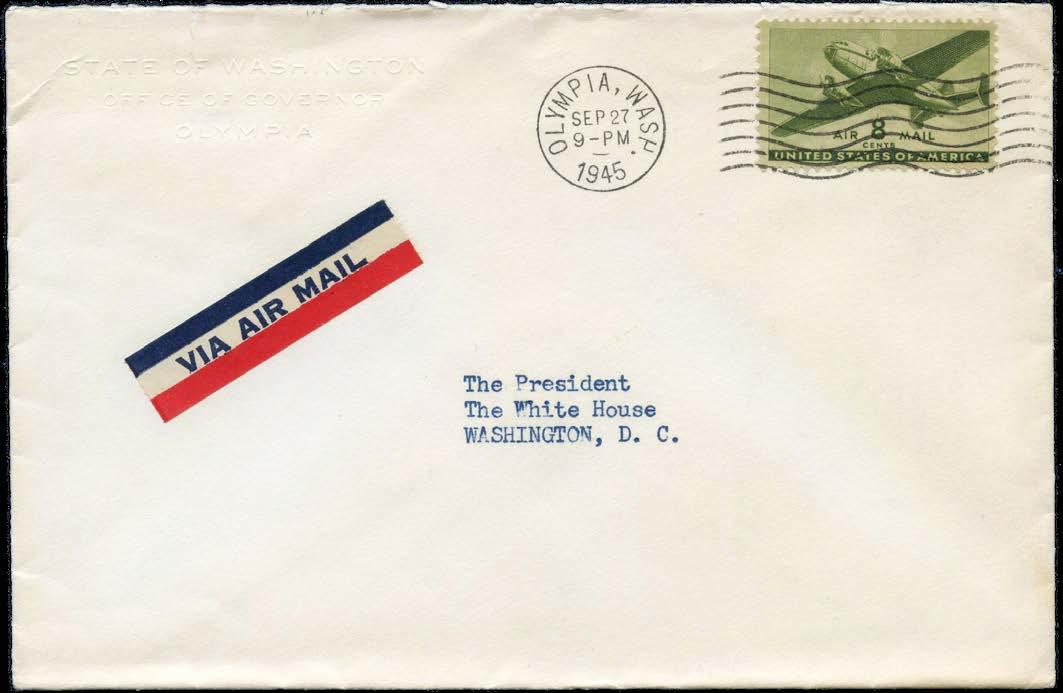
Figure 1. Airmail cover sent to President Harry S. Truman on September 27, 1945.
Of greater philatelic interest is my cover sent to “President Harry S. Truman” on special Colonial Airlines stationery shown in Figure 2. Note especially the “Air Route Bond” paper used for the envelope and the shaking hands graphic on the back, symbolizing international cooperation. Colonial Airlines was founded as Canadian Colonial Airways in 1928, operating between Montreal and New York City. When the Civil Aeronautics Board (CAB) refused to grant it a foreign carrier permit in 1942, it was acquired by a group of investors and renamed Colonial Airlines. In 1945, it was awarded routes from Washington, D.C., to Canada, and the cachet on this cover celebrates the First United States Air Mail Service from Washington to Ottawa on April 15, 1946. Cancellations reveal that this airmail cover left Washington at 7:30 am and arrived in Ottawa at 3 pm.
Shown in Figure 3 is my official business cover sent to Truman by the Department of the Interior, Office of the Governor of Hawaii, on May 28, 1946. It is addressed simply to “The President” at the White House. Interestingly, the cover is franked by two 15¢ perfined “T. H.” Transport Airmail stamps, paying the double rate. The 15¢ rate for Hawaii had been in effect since January 15, 1945. After the war ended, the domestic airmail rate decreased to 5¢ on October 1, 1946, and this new rate also applied to all US possessions. Before
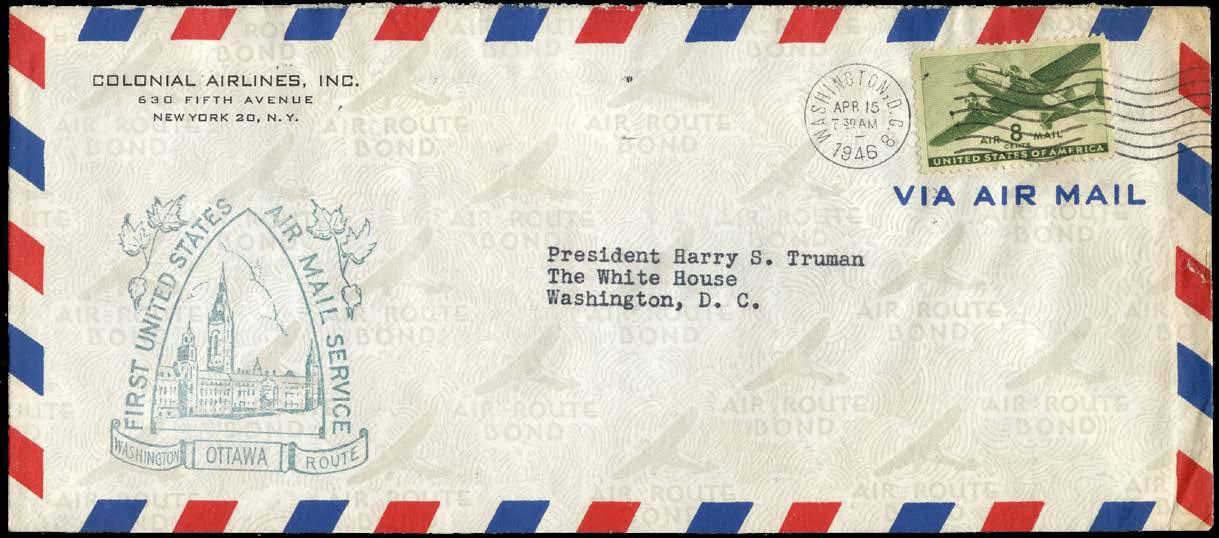
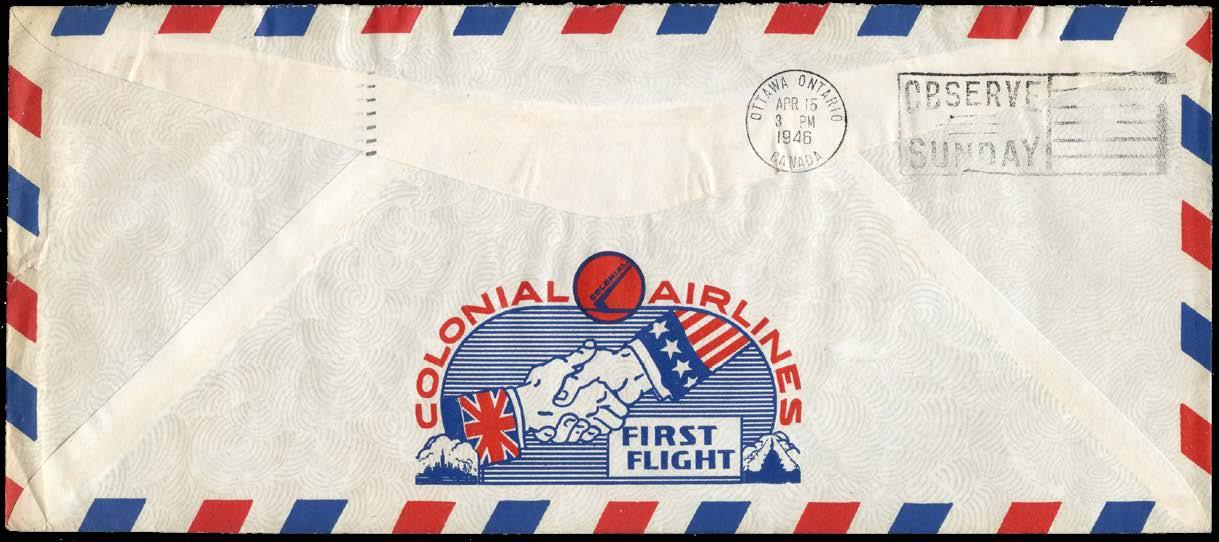
Hawaii became a state in 1959, the governor of the Territory of Hawaii was appointed by the US president. While the territorial governor handled day-to-day business at the local level, it was the Department of the Interior that actually administered the Territory of Hawaii. In any case, the territorial governor of Hawaii in 1946 was Ingram Stainback, who was appointed by Franklin Roosevelt in August 1942 and remained in office under Truman until May 6, 1951.

Figure 2. Colonial Airlines First Flight cover sent to Truman on April 15, 1946.
Figure 3. Office of the Governor of Hawaii double-weight airmail cover sent to Truman on May 28, 1946.
In Figure 4, Hawaii’s Territorial Governor Ingram Stainback is shown greeting President Harry Truman in Honolulu with a welcoming lei in October 1950. The President then continued on to Wake Island for a meeting with General Douglas MacArthur concerning the Korean Conflict. Famously, less than a year later, Truman fired MacArthur for insubordination.

Figure 4. Truman being welcomed by the Governor of Hawaii in October 1950.
The last of my Transport Airmail covers mailed to Truman is shown in Figure 5. This is a First Helicopter Flight cover from Bridgeport, Connecticut, postmarked July 6, 1946. Sent during New England Air Mail Week, as shown by the added cachet, this commemorates the first airmail delivery by a Sikorsky S-51 helicopter from the Bridgeport post office. Interestingly, these helicopters were produced locally by the Sikorsky Aviation Corporation.
My cover also included the matching enclosure sent to Truman, shown in Figure 6. This touts New England Air Mail Week, Igor Sikorsky, who was the inventor of the helicopter, and Bridgeport as the “Industrial Capital of Connecticut.” It also praises Bridgeport’s public parks, hotels, and restaurants, and so forth, along with the fact that Bridgeport had once been the home of P. T. Barnum, the “world’s greatest showman.”
Harry S. Truman is now regarded by historians as being among the most consequential of U.S. presidents, especially for his handling of the aftermath of World War II, when Truman implemented the Marshall Plan to rebuild the economies of Western Europe, and established both the Truman Doctrine and NATO to contain the expansion of Soviet communism. Truman famously had a sign on his desk that read “The Buck Stops Here,” which clearly represented his no-nonsense approach to leadership and accountability.
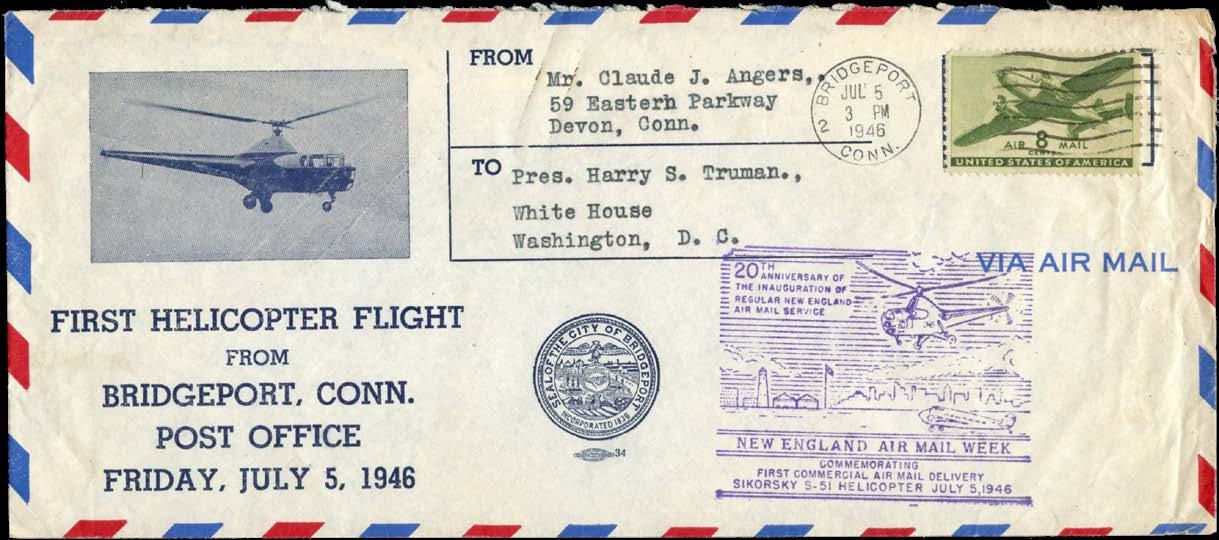

Figure 5. First Helicopter Flight cover sent to Truman from Bridgeport, Connecticut, on July 6, 1946.
Figure 6. First Helicopter Flight cover enclosure mailed to Truman.
Regarding the 8¢ Transport Airmail stamp itself, it had a relatively brief period of usage, being introduced on March 21, 1944, while Harry Truman was still a United States Senator. Later that same year, Truman was selected as FDR’s running mate for the 1944 election and was sworn in as vice president on January 20, 1945. When FDR suddenly died in office, Harry Truman became president on April 12, 1945.
Following the end of World War II and the return to peace, the airmail rate remained at 8¢ for a little over a year before being reduced to 5¢. This is a relatively short period, and so I count myself lucky to have a number of examples of Transport Airmail covers that were sent to President Harry S. Truman in my collection.
For readers interested in more information about the Transport Airmail Series, see my previous articles2 in The United States Specialist and G. H. Davis’s excellent book,1 The Transports, available as a free PDF download to all members of The United States Stamp Society at our website under Resources.
References
1. G. H. Davis, The Transports, Bureau Issues Association: Reston, VA 1999.
2. Paul M. Holland, various articles on the 1941 Transport Airmail Series, in the May, June, August, The United States Specialist
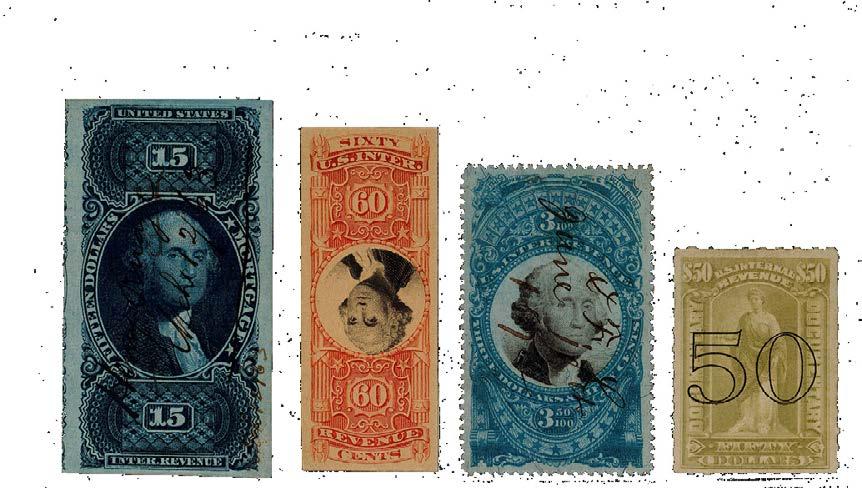




Twelfth International Philatelic Exhibition of the United States proudly presented by







• The Boston Convention and Exhibition Center is located fifteen minutes from Boston Logan International Airport. It is ten minutes from South Station and Amtrak Acela Express to New York City and Washington DC.
• All show hotels will be within walking distance.
• In a 352,000 square foot contiguous exhibition area, BOSTON 2026 WORLD EXPO will be hosting a large dealer and postal administration bourse, as well as a large society presence and hundreds of meetings/events.
• There will be a competitive exhibition of approximately 3,500 frames, plus other special/court of honor exhibits, as well as a large literature competition.


First Automated Post Office
by Rodney A. Juell USSS #13852 | P.O. Box 3508, Joliet, IL 60434
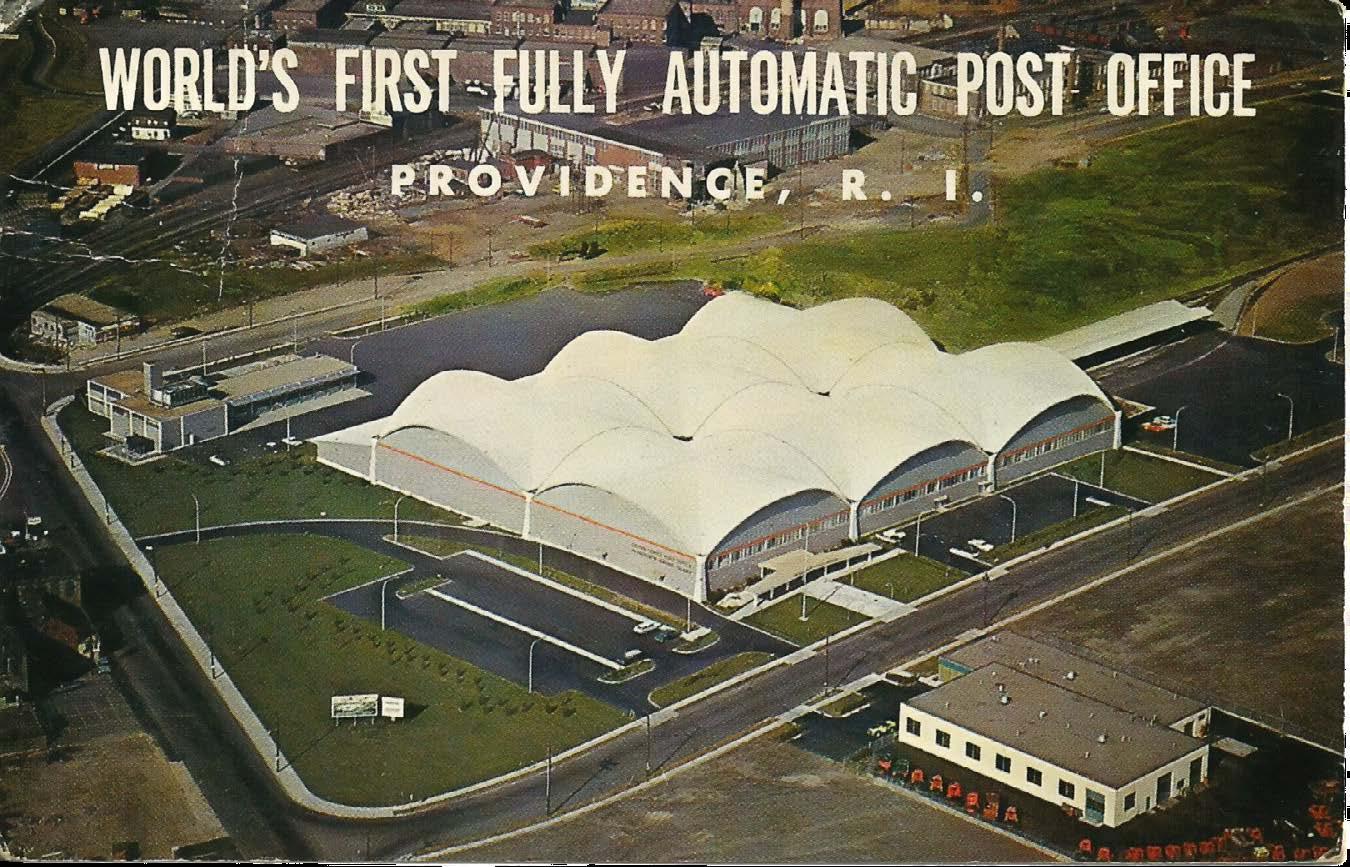
In the late 1950s the Post Office Department needed to modernize mail processing in order to keep up with increasing volumes of mail. This month’s photo is a picture post card of one modernizing effort. What was called “The First Automated Post Office in the United States” is shown. Also shown nearby is the program from the dedication of that Post Office, located in Providence, Rhode Island. A stamp, Scott 1164, was issued to mark the event.
Vintage Photo of the Month
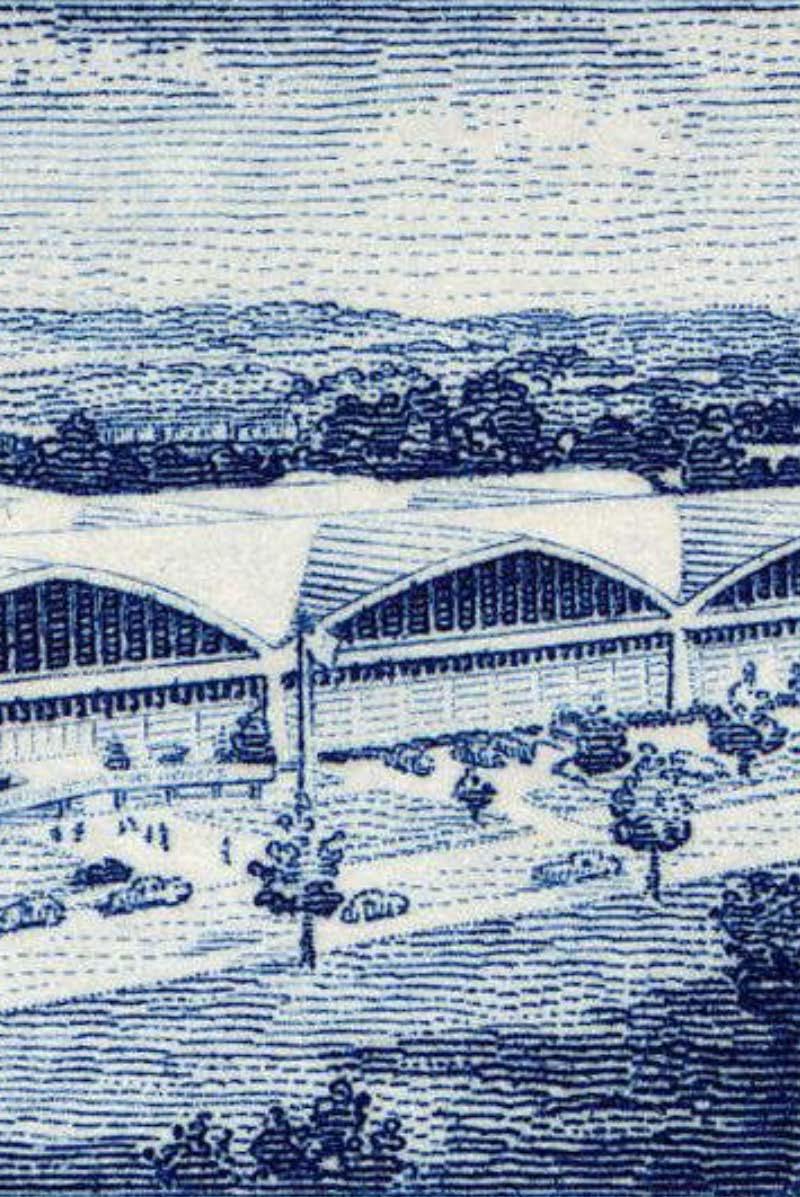



Great Americans Issue Part XVIII—
By the Numbers
by Jay Stotts
USSS #10921 | m stottsjd@swbell.net

The previous 17 parts of this series have provided readers with a detailed, chronological history of the Great Americans Issue (GA), a set of definitive postage stamps as they were printed and unveiled by the United States Postal Service (USPS).
Twenty Years in the Making
The first issue was a 19¢ stamp featuring a likeness of Native American Sequoyah, issued on December 27, 1980. The last stamp in the series, the 55¢ Justin Morrill issue, was released on July 17, 1999. Considering some designing and planning time prior to the release of the first stamp, this issue was twenty years in the making, unlike any previous issue.
No other single US definitive series covered twenty years from its introduction through its last face-different design. The Classics era consisted of seven major issues, most designated by their issue date nicknames such as the 1851s, 1861s, or 1867s and most saw much shorter reigns. The Large Banknote era did cover about twenty years, from
The Great Americans
Figure 1. Ralph Bunche, one of two African Americans pictured on a Great Americans stamp.
1870 to 1890, but at least three contract suppliers (National, Continental, and American) handled the production, introducing several changes along the way, including paper changes, secret marks, and grills.
Among the previous eight Bureau of Engraving and Printing (BEP) definitive issues, most ranged in duration from under ten years (the 1902 Series, which dominated from 1902 to 1908) to as much as 16 years. Both the Fourth Bureau Issue (dominant from 1922 to 1938) and the Presidential Issue, or Prexies (dominant from 1938 to 1954), fell within that range. However, in both issues, new designs were not forthcoming toward the end of their tenure.
Subjects Pictured on the Stamps
There are 63 face-different stamps in the series. Only one stamp features two people, so there are 64 personalities featured. Of the 64, 15 (23%) were women and 49 were men. By birth, four (6%) were Native Americans, seven (11%) were foreign-born, and the rest were born on US or on its territorial soil. Only two were African-American. See Figure 1.
All of the personalities featured on these stamps achieved their legacy as stamp subjects by accomplishments in their field of expertise or by their actions on behalf of others. Although most of these individuals can be grouped in one of fourteen different fields of expertise, many could have been listed in multiple fields. See Figure 2. Limiting each subject to the best fit, the following categories led with the most representatives: statesmen (11), military (9), educators (9), writers (6), scientists (5), the medical field (5), philanthropists (5), and advocates and activists (4). As you can see, there was no underlying dominant factor for securing a spot in this series of stamps. Keep in mind that, as the set evolved into the 1990s, some people who had made the set as 32¢ values were initially nominated as candidates for a commemorative stamp.
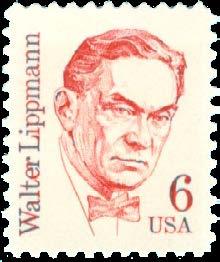

2. Thomas Gallaudet, both an educator and an advocate for the deaf.
Referring back to one of the series’ nicknames, The Unknown Americans, it is difficult to summarize just how many of these subjects were previously known to the average American before their stamps were released, but certainly, many were not widely known.
Arguably, the two presidents featured, Thomas Jefferson and Harry Truman, should make the list of those widely known. And others come to mind as well, especially to those of us who know history as a result of collecting stamps – perhaps Sitting Bull, James Audubon, Chester Nimitz, Earl Warren, and Milton Hershey? Avid readers would have recognized authors such as Jack London, Bret Harte, Sinclair Lewis, Margaret Mitchell, and Pearl Buck. But clearly, lack of being widely known plagued most of the subjects. How about Walter Lippmann, pictured in Figure 3?
For fun, we compared the number of stamps printed to the basic color reported for the issue by the USPS. To avoid comparing 64 stamp issues against 60-plus colors, we didn’t use the Scott-listed colors. We used the listed colors on the USPS Postal Bulletin announcement for each stamp. For example, the original stamp’s issued color in USPS
Figure
Figure 3. How widely known was Walter Lippmann before this stamp?
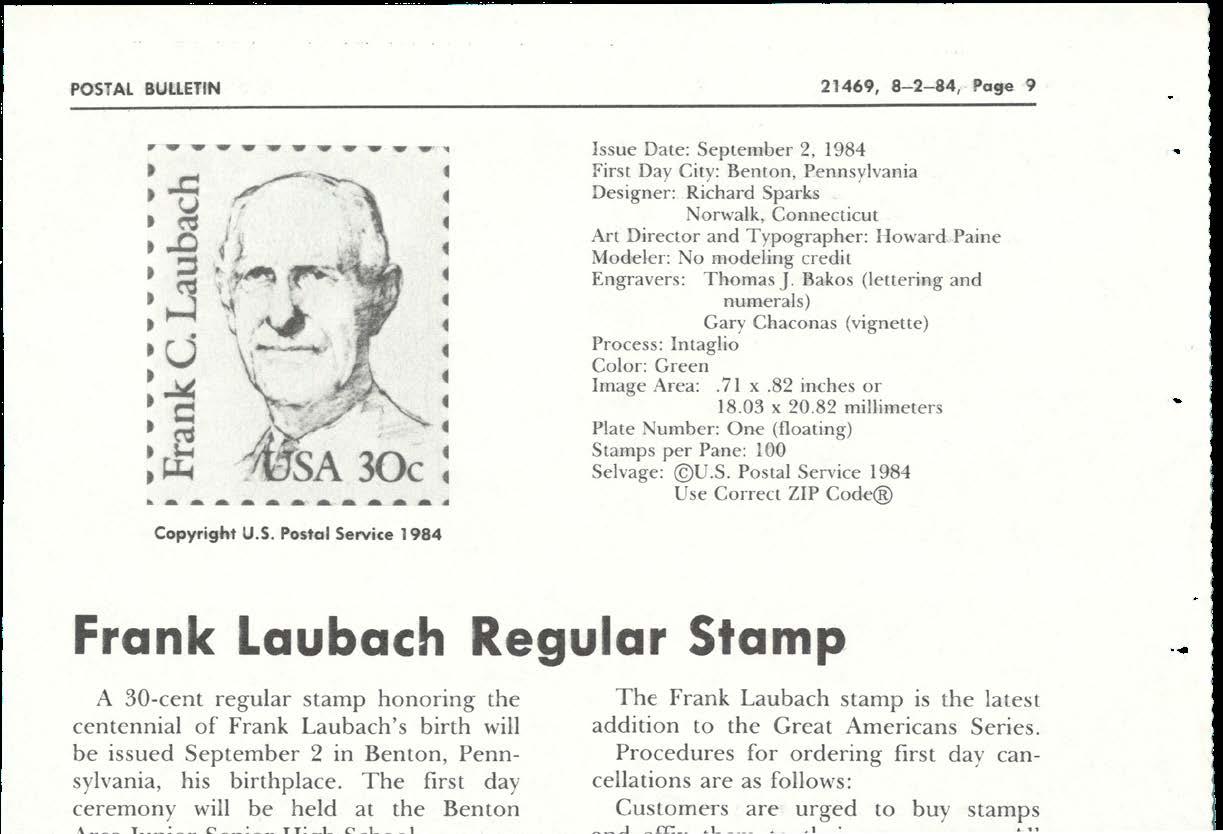
Figure 4. Announcement of the Laubach stamp to be issued as a green stamp.
public announcements for some stamps was “green” as follows (the Scott color name is listed in parenthesis): 3¢ Clay (olive green), 5¢ Black (dark olive green), 9¢ Thayer (dark green), 17¢ Carson (green), 20¢ Gallaudet (green), 30¢ Laubach (olive gray) and 40¢ Gilbreth (dark green).
From stamp announcements, blue hues were the most popular with 16 stamps printed in that family. Green hues followed with 14, and purple/violet hues had eight. Red/crimson/scarlet hues also had eight.
In at least two cases, Scott listed a different color family than the postal announcement. For instance, the 30¢ Laubach stamp was announced as issued in green by the USPS, but is listed in Scott as a shade of gray, specifically olive gray. A portion of the Laubach announcement is shown in Figure 4, and the stamp is shown in Figure 5.
Issuing Formats
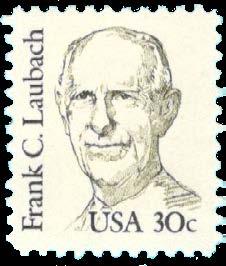
Figure 5. The Laubach stamp in a color Scott describes as olive gray.
Because the Transportation Coils were concurrent with the Great Americans, no coil stamps were issued for the GA Series. Only one value, the 25¢ Jack London stamp, was issued in booklet pane formats. Booklet panes of six and ten stamps were produced so that the stamp could be sold in booklets of $1.50, $3.00, or $5.00 during the 25¢ domestic letter rate period.
All 63 face-different values were sold in sheet formats. The familiar 100-subject counter panes were originally the standard fare and applied to 57 of the GA stamps. The
remaining six stamps ($5 Harte, $1 Hopkins, 32¢ Luce, 32¢ Wallace, 77¢ Breckinridge, and 55¢ Morrill) were issued in counter panes of 20 stamps.
Sixty-one of the stamps were the traditional lick-and-stick adhesive variety, and the last two (Breckinridge and Morrill) were the now-preferred self-adhesive stamps.
The first 12 stamps in the series were printed at the BEP on age-old Cottrell presses, the state-of-the-art at the time. After a 1982 fire at the BEP Annex, production was switched to the BEP’s A Press, and 34 different designs were, at one point or another, printed on this press. High stamp production at the BEP in 1985 caused three values to be printed on I-8 currency presses. Attempts at modernization at the BEP created a family of presses (C, D, and F Presses) with interchangeable printing sleeves, and 16 different values were printed on these presses. Finally, when the USPS employed contract printers, 12 different designs were printed by outside concerns.
Postal Rate Periods
Throughout the series of issues, we frequently mentioned the need for a new value to pay a new postage rate. Throughout the tenure of the Great Americans Series, eight different domestic first-class letter rates were in effect. When the Sequoyah stamp was issued in December 1980, the domestic letter rate was 15¢ for the first ounce. By 1999, when the Morrill stamp was released, the domestic letter rate had more than doubled to 33¢.
Twelve different GA stamps were available to pay the single-ounce domestic letter rate during this period. Four more values of GAs directly paid the fee for a second ounce on domestic letters, seven more paid the postage due on a two-ounce letter, and five more paid the triple weight letter rate. Additionally, the 46¢ Benedict stamp paid the combined weight rate for the second and third ounces, but not the first ounce fee, following the 1995 rate increase. So, 29 of the 63 stamps can be tied back to domestic letter rate fees during the period.
Of course, there were many more classes of mail beyond first-class domestic letter rates. Transportation Coils, with all their fractional values, addressed the myriad bulk, nonprofit, and quantity sort rates, but Great Americans provided postage for most of the single-piece mailings costing $5 and below. For instance, six different GA stamps were available to pay the domestic postcard rates throughout the period.
Is There More?
We’ve covered the details of the issue through the 63 stamps issued, so is there more to share? Our next installment will share the story of a person who was considered but was not honored as a subject on a Great Americans stamp.

The Coming and Going of China Clay in BEP Printing Paper.
Part III: Kaolin Content Trends in the Paper Used to Print Regular Issue, Commemorative, and Airmail Stamps Between 1935 and 1955
by Harry G. Brittain, P h D USSS # 16446 | m hgbrittain@gmail.com

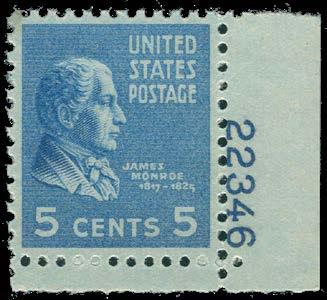
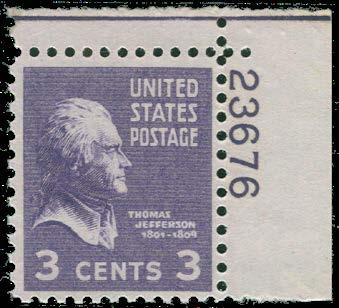
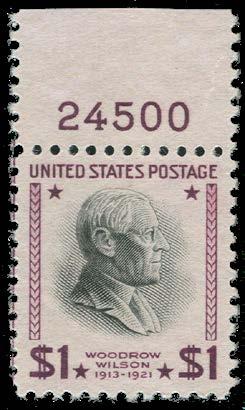
In a series of papers, I have detailed studies where I used the forensic technique of X-ray diffraction (XRD) to track the kaolin content contained in the paper used by the Bureau of Engraving and Printing (BEP) to print US postage stamps between 1894 and 1935.1-5 At one point in time, the existence of kaolin (also known as “China Clay”) in BEP printing paper was a topic of much discussion, but my previous studies have shown that the kaolin content in stamps issued by the BEP was complicated.
In the most recent paper, I provided the following summary that encapsulated all of the measured kaolin content trends associated with regular, commemorative, and airmail issues for stamps printed between 1894 and 1935:
Beginning in 1894, when the BEP took over the printing contract from the American Bank Note Company, all regular issue and commemorative stamps were printed on
Forensic Analysis of Stamp Paper
Figure 1. Four representative examples of Prexie plate number singles used in the study.
kaolin-containing paper. This practice ran without exception until approximately the middle of 1904.
• Around the beginning of 1905, the BEP began issuing stamps printed on either kaolin-containing or kaolin-free paper. This era lasted until midway through 1908, when the BEP ceased issuing stamps on paper containing kaolin.
• Between the middle of 1908 and continuing to the beginning of 1929, all stamps issued by the BEP were printed exclusively on kaolin-free paper.
• Early in 1929, and continuing to the beginning of 1930, the BEP issued regular stamps (i.e., the Fourth Bureau series) on either kaolin-free or kaolin-containing paper. Interestingly, within this time period, the BEP used only kaolin-containing paper for its commemorative and airmail stamps. This latter aspect of the timeline spanned from the middle of 1929 to the middle of 1931.
• Finally, at the beginning of 1930, the BEP used only kaolin-containing paper in its issuance of regular, commemorative, and airmail issues. This practice continued through the end of 1934, at which point the most recent publication5 of this series concluded.
It should not be a surprise that there remains great interest in understanding the nature of the printing paper used by the BEP as part of its continuing mission to provide postage stamps to the American people.
Accordingly, this article reports studies of the kaolin contents of regular, commemorative, and airmail stamps issued by the BEP between 1935 and 1955. Every stamp assayed as part of the study had an attached plate number, indicating its approximate date of printing. Owing to its particular interest to collectors, results obtained on 805 plate-numbered stamps of the Presidential Series (“Prexies”) will be presented as a separate category in the regular issue aspect of this work, separate from the 376 other regular issue stamps. The kaolin content of 798 commemorative stamps constitutes a third category of study, and results obtained on 233 airmail stamps will make up the fourth and final category. When summed up, the kaolin content results of the current paper represent analyses conducted on a total of 2,212 stamps. It may be noted at this point that the XRD patterns of every one of these stamps demonstrated that their printing papers contain significant amounts of kaolin, and that no stamps were found to have been printed on kaolin-free paper.
Methodology Summary
The forensic methodology used in the present work is unchanged relative to that used previously.6 When kaolin is present in a given sample of printing paper, its presence is manifested in an XRD pattern by its two defining peaks observed at angles of 12.3 degrees 2θ and 24.9 degrees 2θ. The analytical method for calculating the kaolin content in a given sample consists of measurement of the intensity of the kaolin peak at 12.3 degrees 2θ, followed by the calculation that uses a simple linear relationship to relate XRD peak intensity with kaolin content. The equation relating peak intensity with kaolin content was developed through the analysis of prepared reference samples.
The B.I.A. Plate Number Checklist7 correlates plate and Scott numbers with “first to press” (FTP) printing dates, allowing one to approximate when a given plate was first used for printing. As described in preceding papers,4,5 I use Microsoft Excel functions
to convert the listed “month/day/year” dates into a decimal-based format suitable for plotting.
Regular Issue Stamps of the Presidential Series
Beginning in 1938, the Bureau began to issue a fifth series of stamps featuring the images of all 29 presidents who held office between 1789 and 1928, and for this reason, the stamps of this series are termed as belonging to the Presidential Series (or more affectionately, the “Prexies”). The series consisted of 32 stamps, which have been of great interest to collectors. It is beyond the scope of this article to individually discuss the members of this series; therefore, interested readers are referred to the comprehensive review published by Rustad,8 which is available for viewing on the USSS website.
In the present work, the XRD patterns of a total of 805 unique plate-numbered stamps were acquired for the determination of their kaolin content. Four representative examples are illustrated in Figure 1, corresponding to the 1935–1940, 1940–1945, 1945–1950, and 1950–1955 time intervals. Table 1 contains a detailed breakdown of the Scott numbers, denominations, and counts of the actual stamps assayed during this work.
Figure 2 plots the kaolin contents measured for the printing paper of the 805 Presidential Series stamps, and this figure contains trends worthy of discussion. In the preceding paper in this series,5 it was noted that at the beginning of 1930, the printing of regular issue stamps exclusively used kaolin-containing paper with 5% to 20% kaolin. The results shown in Figure 2 show that after 1941, some of the Presidential stamps were

Figure 2. Summary of the kaolin content measured for regular issue stamps of the Presidential Series within the 1935–1954 “first to press” time period. The figure contains the color-coding that defines the illustrated categories, which is defined in greater detail in Table 1.
Category from Figure 2
½¢ to 1¢
Denomination
Scott Number (# stamps assayed)
803(14)
804(91) ½¢ to 2¢
805(85)
806(100)
807(299) 4¢ to 10¢
808(10)
809(4)
810(16)
811(18)
812(7)
813(13)
814(10)
815(16)
816(5)
817(4)
818(6)
819(4)
820(23)
17¢ 822(5)
18¢ 823(4)
19¢ 824(5)
20¢ 825(10)
21¢ 826(4)
11¢ to 50¢ 16¢ 821(4)
22¢ 827(2)
24¢ 828(8)
25¢ 829(14)
30¢ 830(5)
50¢ 831(2)
$1 832/832C(24)
$1 to $2
$2 833(3)
Table 1. Classifications of the Presidential Series stamps according to the groupings of Figure 2
printed on paper containing significantly higher amounts of kaolin. In fact, the paper used to print most of the stamps between 1943 and 1948 contained 15% to 30% kaolin. After 1949, the amount of kaolin in printing paper decreased considerably, with most papers containing only 5% to 20% kaolin.
The rationale for switching to printing paper containing 15% to 30% kaolin content during the 1943–1948 period is unknown, but the timing of this period overlaps
considerably with that of World War II. It is conceivable that the regular stock of stamp printing paper was strongly affected by the needs of the war, and that the economics of stamp printing required that the BEP presses use whatever paper they could acquire. Continuing this line of reasoning, it is quite conceivable that once the war ended and supply chains returned to normal, the more “regular” paper had again become available for printing purposes. While the reasoning might be conjecture, the trends in kaolin content are solid facts derived from the conduct of experimental studies.
“Other” Regular Issue Stamps of the 1935–1955 Time Period
Of the 1,181 regular stamps studied within the 1935–1955 time period, the XRD studies of the present work include a total of 376 “other” regular issue stamps whose kaolin contents were assayed. These included a variety of stamps, ranging from the leftovers of the Fourth BEP Series through the initiation of the Sixth BEP (Liberty) Series. Representative examples from this category are shown in Figure 3, and a more detailed accounting of the stamps studied is provided in Table 2.
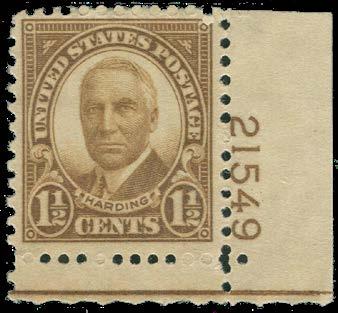
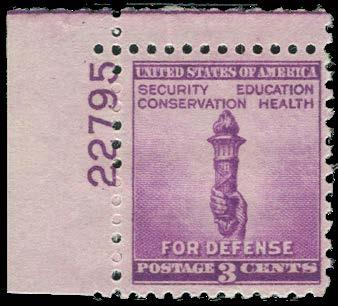
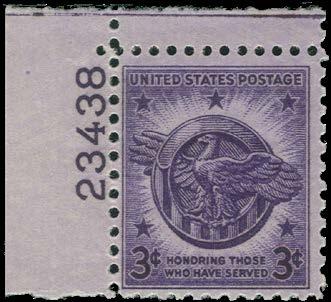
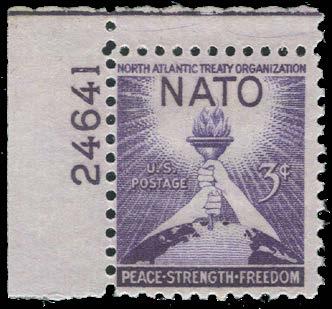
When plotted against a linear timeline, trends in the kaolin contents of the “other” regular issues fit well with the trends just described for the stamps of the Presidential Series. Between 1935 and 1942, these stamps were printed on paper containing 5% to 20% kaolin. There is a significant gap between the middle of 1938 and the middle of 1940 during which no “other” regular stamps were sent to the printer. This gap is not surprising since it corresponds to a high level of printing activity associated with the new Presidential Series.
In the middle of 1940, printing returned in earnest to support the war effort with the issuance of the various “National Defense” (mainly Scott 899, 900, and 901) stamps. Most of these stamps were printed on paper containing 5% to 15% kaolin, but during the Second World War, the “Win the War” stamps (Scott 905) were printed on paper containing a significantly higher degree of (15% to 30%) kaolin content. After the war, no “other” regular category stamps were issued until 1952, when most of the Scott 1008 “NATO: Peace-Strength-Freedom” were printed on paper containing 10%-20% kaolin. Since the scope of the present work includes stamps printed before 1955, Figure 2 necessarily contains kaolin content for the Scott 1035 and 1041 issues of the Sixth (Liberty) Series. Examination of their portion of Figure 2 reveals that these introductory stamps were printed on paper containing a very wide range of kaolin content. Discussion of these stamps is beyond the scope of the present work, but it is known that the BEP began to experiment with different kinds of paper for the Liberty Series. As a future paper will
Figure 3. Representative examples of the 1935–1955 regular issues examined for the study.
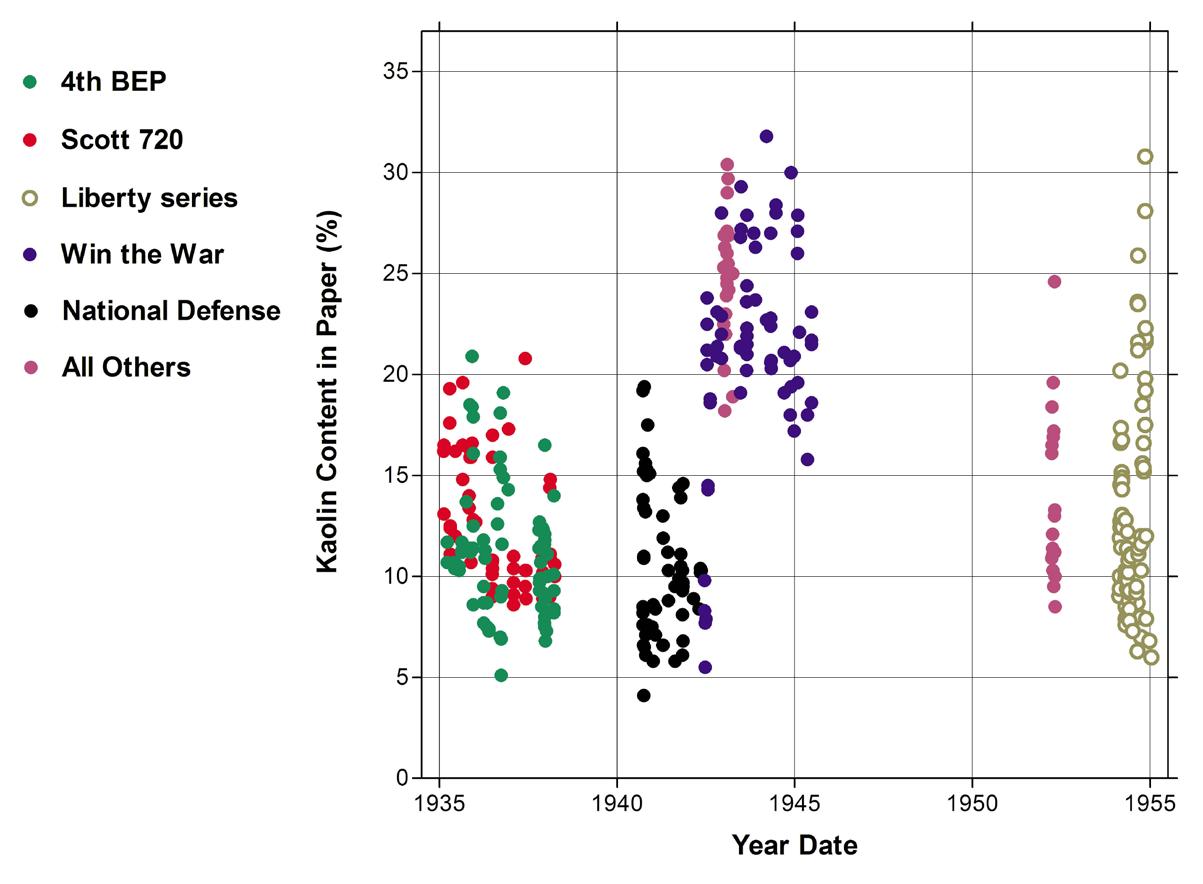
Figure 4. Summary of the kaolin content measured for the other regular issue stamps within the 1935–1954 “first to press” time period. The figure contains the color-coding that defines the illustrated categories, which is defined in greater detail in Table 2.
Category from Figure 4 Denomination
4th Bureau Issue
Scott Number (# stamps assayed)
632(24)
684(21)
634(28) Scott 720
1038(4)
1041(22)
Table 2. Classifications of the other regular issue stamps within the 1935 to 1954 “first to press” time period according to the groupings of Figure 4.
show, not only did kaolin content values vary considerably, but XRD patterns also show the existence of additional crystalline components in the paper. Furthermore, the FTIR spectra of the stamps in this series demonstrate that the ink compositions used to print these stamps were completely unlike any of those used before 1955. That is definitely a story for another day.
Commemorative Stamps of the 1935–1955 Time Period
The 1935–1955 time period was a prolific era for the BEP, as it issued over 190 Scottnumbered commemorative stamps. In a monumental effort of compulsiveness, I have not only obtained the XRD patterns of all these issues, but I have also obtained XRD patterns for every uniquely plate-numbered stamp associated with each issue. This aspect of the present study consisted of XRD analysis of 798 stamps, precluding discussion of the details associated with individual Scott numbers. Fortunately, the history of most of these issues has been previously described by either Johl9 or by Glass.10
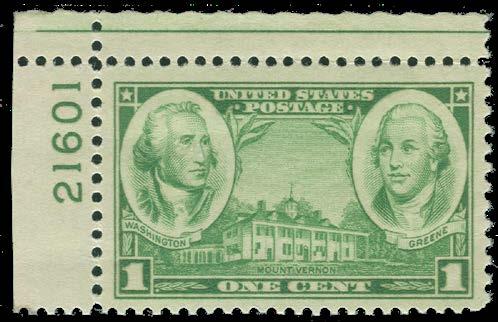

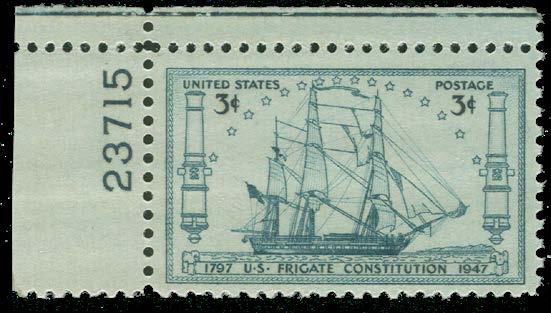
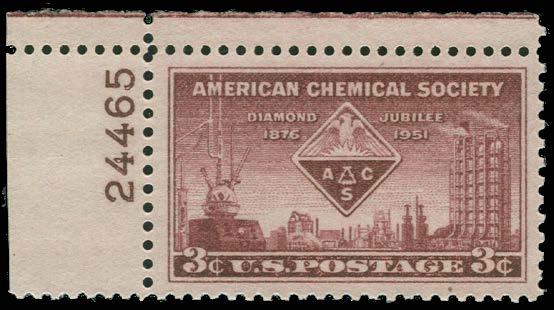
Figure 5 contains four representative examples of commemorative stamps issued within this time period, and the category breakdown of Table 3 further annotates the scope of this part of the work.
Figure 6 illustrates the kaolin content contained in the commemorative stamps of this time period, and one is immediately struck by the near absence of commemoratives issued between 1941 and 1944. It cannot be a coincidence that this gap coincides with the timeframe of World War II, during which the BEP was presumably more concerned with supporting the war effort. Referring back to Figures 2 and 4, it is clear that the postage stamp printing efforts were nearly exclusively devoted to printing and issuing definitive stamps.
Figure 5. Representative examples of commemorative stamps of the 1935–1955 examined for the study.
Category from Figure 3 Denomination
1¢ 785(4), 790(4)
2¢ 786(4), 791(4)
Scott Number (# stamps assayed)
Army-Navy
Events: 1935–1947
Events: 1948–1955
Famous Americans
Individuals
Military
Organizations
States-Territories
US Sesquicentennial
3¢ 787(4), 792(4)
4¢ 788(4), 793(4)
5¢ 789(4), 794(4)
3¢ 773(6), 774(12), 775(4), 836(8), 852(4), 853(4), 855(4), 857(4), 894(4), 895(2), 898(4), 902(4), 922(2), 923(2), 924(2), 926(2), 943(6), 944(8), 946(6), 947(4), 952(6), 954(6), 961(4), 962(2), 963(4), 974(4), 977(4), 978(4), 982(6), 983(6), 984(6)
5¢ 796(4), 928(4), 958(4)
3¢ 1000(6), 1003(6), 1006(6), 1009(6), 1010(6), 1011(6), 1014(6), 1015(6), 1020(6), 1027(6), 1028(6), 1029(4), 1063(4), 1064(4)
5¢ 1021(4)
1¢ 859(2), 864(2), 869(2), 874(2), 879(2), 884(2), 889(2)
2¢ 860(4), 865(2), 870(2), 875(2), 880(2), 885(2), 890(2)
3¢ 861(4), 866(2), 871(2), 876(2), 881(2), 886(2), 891(2), 937(4), 945(6), 953(4), 960(4), 965(4), 975(4), 980(2), 986(4), 988(4)
5¢ 862(2), 867(2), 872(2), 877(2), 882(2), 887(2), 892(2)
10¢ 863(2), 868(2), 873(2), 878(2), 883(2), 888(2), 893(2)
1¢ 930(6)
2¢ 931(2)
3¢ 932(6), 956(6), 959(4), 1004(6),1062(3), 1072(2)
5¢ 933(2)
3¢ 925(2), 929(6), 934(4), 935(6), 939(4), 940(6), 951(6), 970(4), 976(4), 985(6), 998(4), 1003(6), 1013(6), 1017(6), 1026(6)
5¢ 906(2)
3¢ 949(8), 967(4), 968(4), 969(2), 971(4), 979(4), 987(6), 993(6), 995(6), 1002(6), 1005(4), 1007(6), 1012(6), 1022(6), 1024(4), 1025(6)
3¢ 772(4), 775(4), 776(4), 777(4), 782(4), 783(4), 795(4), 799(4), 800(4), 801(4), 802(4), 837(4), 838(2), 856(8), 858(4), 896(4), 897(4), 903(2), 904(2), 927(2), 938(4), 941(4), 942(6), 950(6), 955(6), 957(4), 964(4), 972(4),981(6), 994(6), 996(6), 997(4), 999(6), 1001(6), 1018(4), 1019(6), 1023(6), 1060(4), 1061(4)
3¢ 798(4), 835(4), 989(6), 990(6), 991(4), 992(2)
Table 3. Classifications of the commemorative issue stamps according to the groupings of Figure 6.
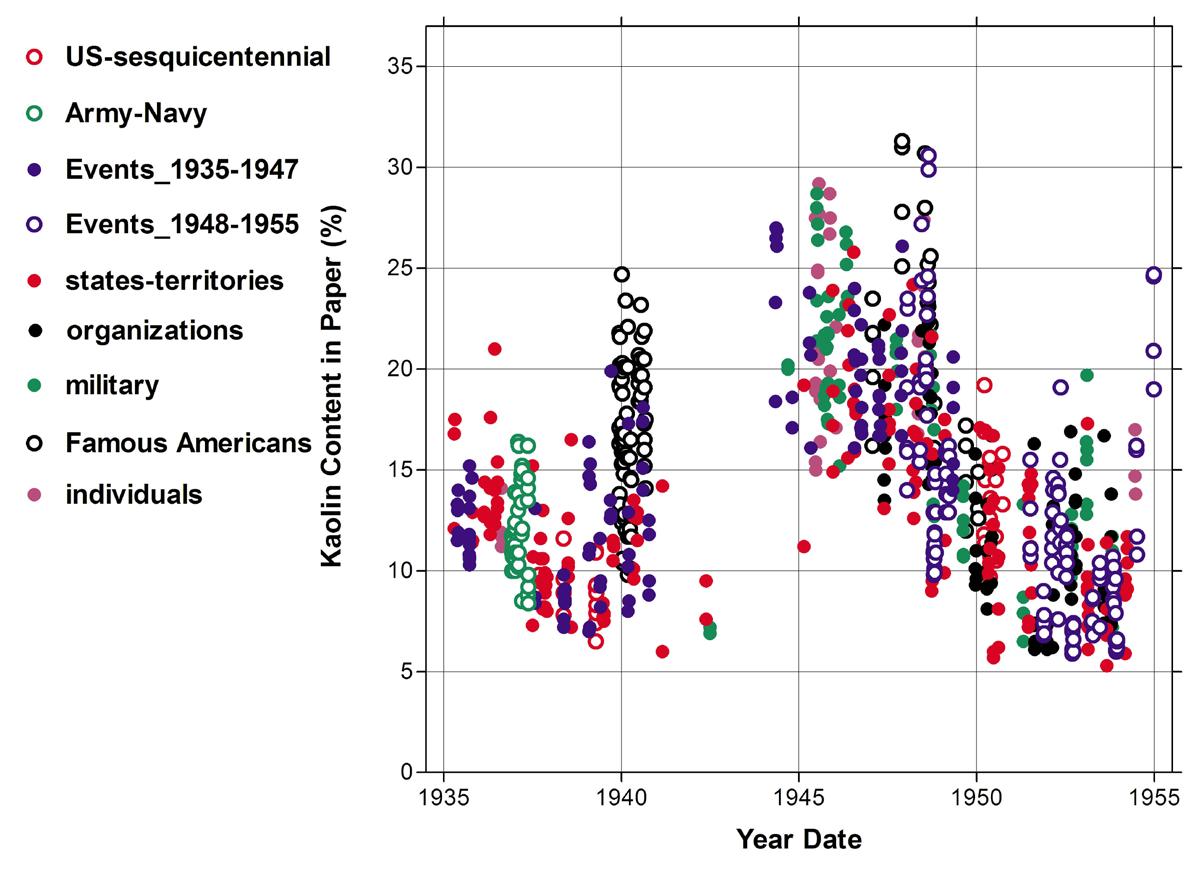
Figure 6. Summary of the kaolin content measured for the commemorative stamps within the 1935–1954 “first to press” time period. The figure contains the color-coding that defines the illustrated categories, which is defined in greater detail in Table 3.
Once the BEP fully resumed printing commemorative issues in 1945, the stamps were printed on paper with a high kaolin content of 10% to 30% until approximately 1949. Beginning in 1949 and running roughly to 1954, the BEP printed those commemorative stamps on paper containing a range of 5% to 20% kaolin.
Airmail Stamps of the 1935–1955 Time Period
The forensic analysis of airmail stamps printed between 1935 and 1955 is a much less daunting task. Including the airmail/special delivery issue of 1936, the BEP printed a total of only 29 Scott-numbered issues; thus, XRD studies were only performed on 233 plate-numbered stamps within the airmail category. Four representative examples of these are shown in Figure 7, and the complete breakdown of the stamps studied may be found in Table 4.
The kaolin plots of Figure 8 show that airmail stamps were printed over a fairly regular schedule between 1935 and 1955. When viewed in its entirety, the overall trend of Figure 8 is the bell-shaped curve that characterized the kaolin contents of the other stamps of this time period. The first cluster of stamps (roughly 1936 to the middle of 1939) was printed on paper containing 10% to 20% kaolin, while most of the stamps within the second cluster (middle of 1941 through 1948) were printed on paper containing the significantly higher kaolin content of 15% to 30%. The third and final cluster consisted of airmail stamps printed between 1949 and 1955 on paper containing only 5% to 18% kaolin.
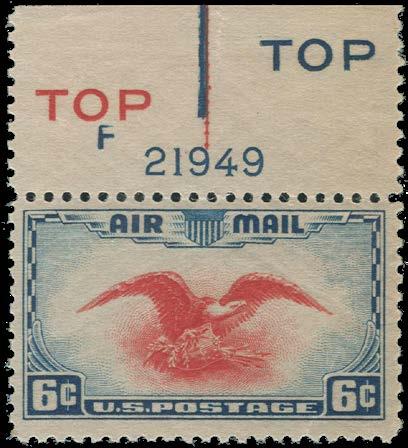


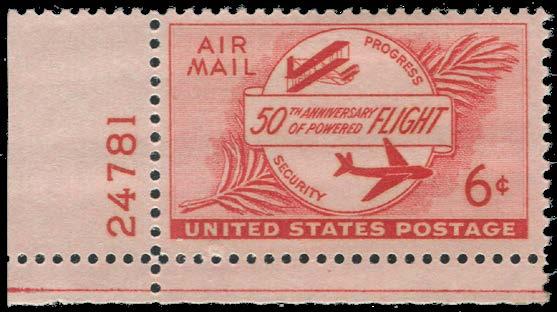
Figure 7. Representative examples of airmail stamps of the 1935–1955 time period examined for the study.
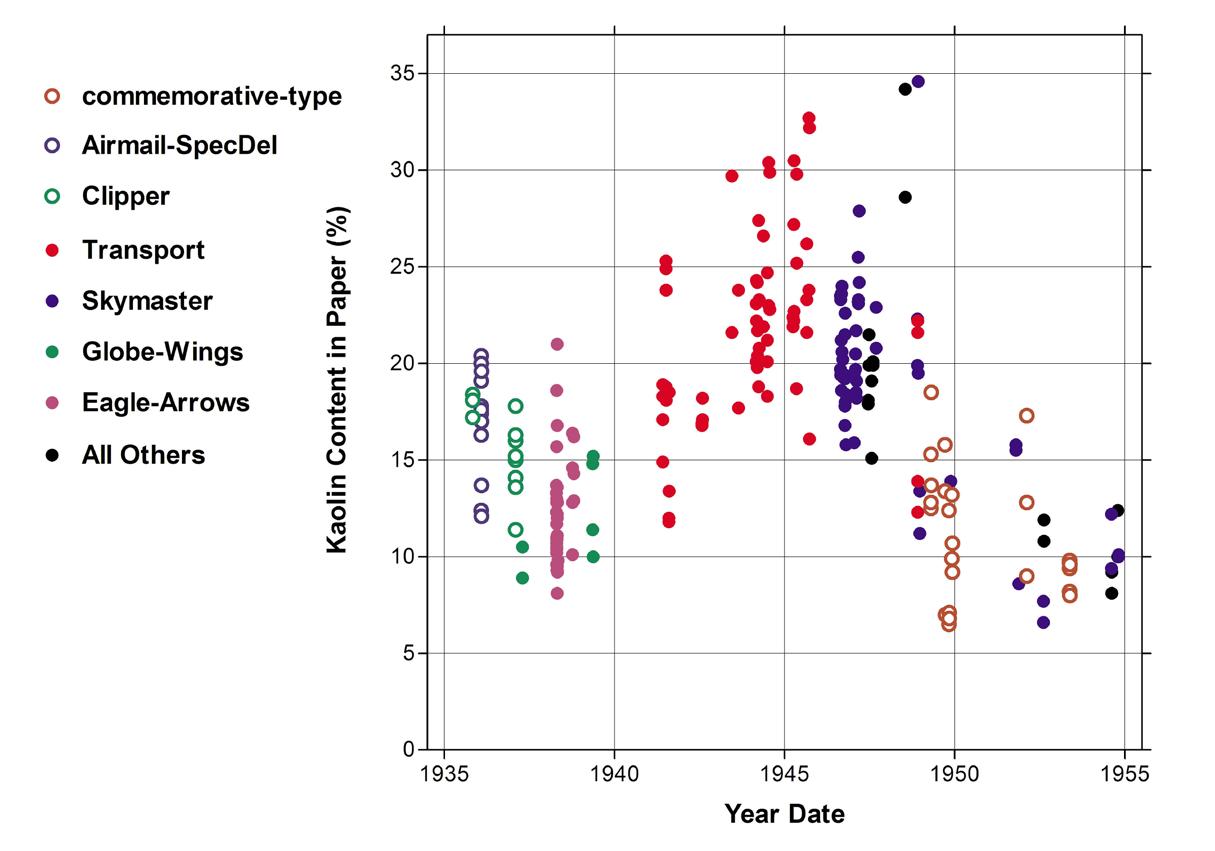
Figure 8. Summary of the kaolin content measured for the airmail stamps within the 1935 to 1954 “first to press” time period. The figure contains the color-coding that defines the illustrated categories, which is defined in greater detail in Table 4.
Category from Figure 8
Commemorative
Air Mail-Special Delivery
Clipper
Transport
Skymaster
Globe and Wings
Eagle-Arrows
All Others
Scott Number (# stamps assayed)
C40(6)
C42(2)
C43(4)
C44(2)
C45(4)
C46(3)
C47(6)
CE2(12)
C21(4)
C20(4)
C22(4)
C25(38)
C26(16)
C27(2)
C28(2)
C29(2)
C30(2)
C31(2)
C32(29)
C33(8)
C39(16)
C19(2)
C24(4)
C23(40)
C34(4)
C35(6)
C36(4)
C38(2)
C48(4)
Table 4. Classifications of the airmail issue stamps according to the groupings of Figure 8.
Summary
The XRD -derived kaolin contents of the entire ensemble of 2,212 stamps of the present study are shown in Figure 9. The first item of note is that every single stamp printed during the 1935–1955 time period was printed on paper containing some amount of kaolin. Not a single instance was found when a stamp of this time period was printed on kaolin-free paper, thus relegating the use of that type of paper entirely to the 1908–1929 time frame.4,5
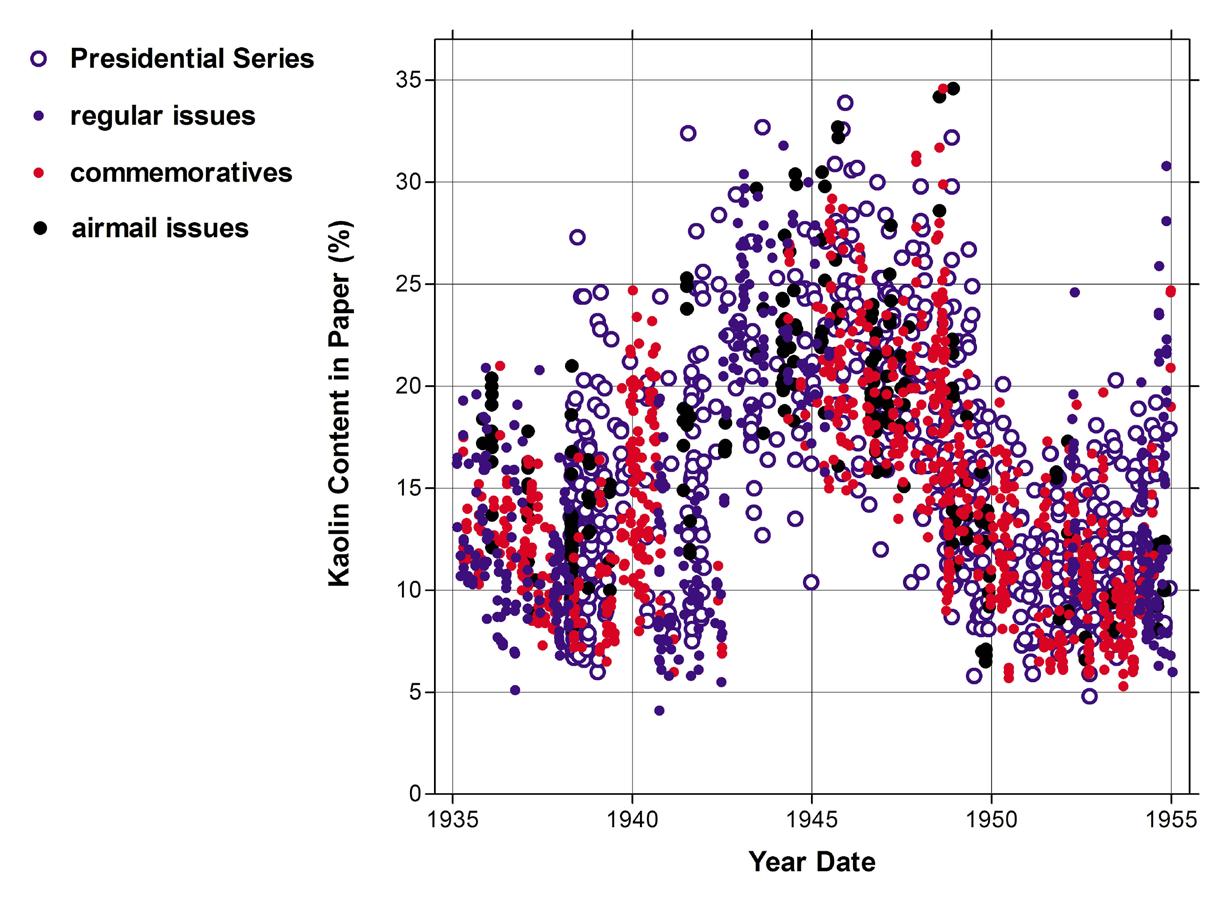
Figure 9. Summary of the kaolin content measured for the regular issue, commemorative, and airmail stamps within the 1935–1954 “first to press” time period.
Examination of the trends in kaolin content of all stamp types of Figure 9 completely confirms that the results are most appropriately considered as being in the form of a bellshaped curve. The segments of that bell-shaped curve then correspond to the following segments within the 1935–1955 timeline:
• Prewar Printings (1935– 1942): The majority of stamps in this time interval were printed on paper containing approximately 5% to 20% kaolin.
• Wartime Printings (1942–1949): The majority of stamps in this time interval were printed on paper containing approximately 15% to 30% kaolin.
• Postwar Printings (1949–1955): The majority of stamps in this time interval were printed on paper containing approximately 5% to 18% kaolin.
The trends in forensic results deduced as a result of the acquisition and analysis of 2,212 XRD patterns reveal much more than the simple numerical results alone. When the results are plotted as a function of their printing dates (as they have been in Figure 9), the result is nothing less than a correlation between forensics and history! This information reveals significant information about the agency responsible for printing the stamps that we so avidly collect, and which would be difficult to document on such an absolute basis by any other way.
So what’s next? As mentioned above, stamps within the Sixth BEP Issue (i.e., the Liberty Series) began to be printed in late 1954. Analysis of the XRD patterns I have obtained thus far (unpublished results) shows that the paper composition situation became far more complicated than the “kaolin-free” and “kaolin-containing” labels deduced in this and my preceding papers. But this is a story still being developed, and which will only be told after the requisite number of forensic results and interpretations has been obtained.
References
1. Harry G. Brittain, “X-Ray Diffraction Study of the Paper Used by the Bureau of Engraving and Printing to Produce 1¢ and 2¢ Stamps Between 1894 and 1913,” The United States Specialist 87, no. 8 (2016): 345–61.
2. Harry G. Brittain, “Kaolin Content in Paper Used by the Bureau of Engraving and Printing to Produce 1¢ and 2¢ Stamps Between 1894 and 1908,” The United States Specialist 90, no. 2 (2019): 61–71.
3. Harry G. Brittain, “X-Ray Diffraction Study of the Kaolin Content in Paper Used to Produce Stamps During 1903–1908,” The United States Specialist 89, no. 9 (2018): 403–16.
4. Harry G. Brittain, “The Coming and Going of China Clay in BEP Printing Paper: Kaolin Content in the 2¢ Stamps of the First, Second, Third, and Fourth Issues,” The United States Specialist 96, no. 6 (2025): 268–81.
5. Harry G. Brittain, “The Coming and Going of China Clay in BEP Printing Paper. Part II: Detailed Analyses of the Return of Kaolin in the Regular Issue, Commemorative, and Airmail Stamps Printed Between 1926 and 1935,” The United States Specialist 96, no. 9 (2025): 393–405.
6. Author’s description of methods: “The XRD diffraction patterns reported in this work were obtained using a Rigaku MiniFlex-II powder diffraction system, equipped with a vertical goniometer operating in the 2θ/θ mode, and a copper X-ray source (using the Kα emission of 1.54184 Å). Each stamp was fixed in a horizontal sample holder and scanned over the range of 3.0–41.0° 2θ at a scan rate of 2.0° 2θ/min with a step size of 0.01° 2θ. The intensity scale was normalized so that the most intense cellulose peak equaled 100%.”
7. W. Wallace Cleland, B.I.A. Plate Number Checklist, Plates 20,000–41303 (Belleville, IL: Bureau Issues Association, 1990).
8. Roland E. Rustad, The Prexies, edited by Leo Piszkiewicz (Belleville, IL: Bureau Issues Association, 1994).
9. Max G. Johl, The United States Commemorative Stamps of the Twentieth Century, Volume II (1935–1947) (New York: H.L. Lindquist, 1947).
10. Sol Glass, United States Postage Stamps, 1945–1952 (West Somerville, MA: Bureau Issues Association, 1954).
Statement of ownership management, and circulation from PS Form 3526 (as required by 39 U.S.C. 3685):
1. The United States Specialist 2. 0164-923X 3. September 30, 2024 4. Monthly 5. 12 6. $25 7. The United States Specialist, PO Box 1602, Hockessin, DE 19707-5602 8. PO Box 1602, Hockessin, DE 197075602. Publisher United States Stamp Society, PO Box 1602, Hockessin, DE 19707-5602 - Editor Andrew S. Kelley, 9038 East 25th Drive, Denver CO 80238 10. United States Stamp Society, Inc., The United States Specialist, PO Box 1602, Hockessin, DE 19707 11. None 12. Has not changed in preceding 12 months 14. September 1, 2025 15b(1). 1253:1218 15b(2). 0:0 15b(3). 0:0 15b(4). 28:28 15c. 1281:1246 15d(1). 11:11 15d(2). 0:0 15d(3). 0:0 15d(4). 0:0 15e. 11:11 15f. 1291:1257 15g. 91:193 15h. 1382:1350 15i. 99.23%:99.12% 16a. 22:22 16b. 1303:1268 16c. 1313:1279 16d. 99.24%:99.13% 17. November 1, 2024 18. Andrew S. Kelley, Editor

Quality United States Stamps (1847-1945)
Singles (mint and used)
Plate Blocks
Booklet Panes plus Complete Booklets
Price lists-$2.00 each category
Price lists free on web: www.mountainsidestampsandcoins.com
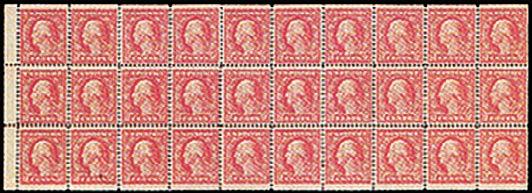
We also buy quality U.S. and foreign stamps
Mountainside Stamps, Coins and Currency
P. O. Box 1116
Mountainside, NJ 07092
Tel: 908-232-0539 or 908-419-9751
E-mail: tjacks@verizon.net
Tom Jacks, owner Member APS, ASDA, USSS
USatFACE.com
If you collect Plate Blocks, Booklets, Coils, or Sheets, the above website, with hundreds of sets at Face Value, will be a great savings to you. Enjoy the hobby.

Armen Hovsepian (APS 150170)
P. O. Box 24222

Overland Park, KS 66283
info@USatFACE.com
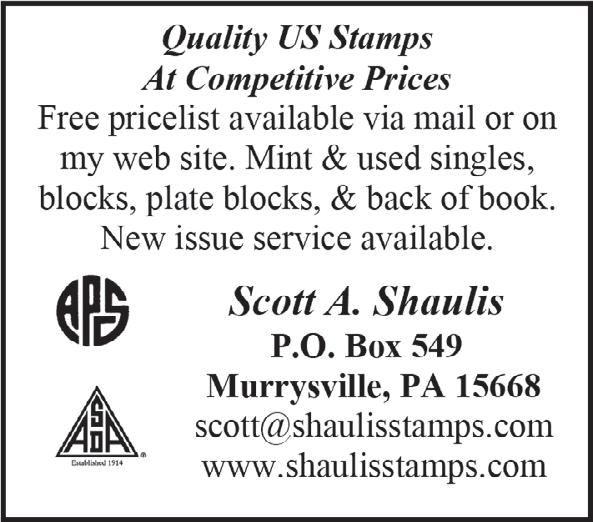
Advertise in The United States Specialist
Deadline for ad copy is the 20th of the second month preceding the month of publication, as April 20 for the June issue. There is a 5% discount for payment in advance or with copy. To place an ad or for help with ad design, contact the Editor, Andrew Kelley, at editor@usstamps.org.

Report of the Executive Secretary
APPLICATIONS RECEIVED FOR SEPTEMBER 2025
17628 Paul Blomquist, Roseville, CA
17629 Bruce Deeter, Bakersfield, CA
17630 William Crawford Jr., N. Chesterfield, VA
17631 Barry Sachs, Kennewick, WA
17632 Dan Keating, Pickerington, OH
APPLICATIONS PENDING
17624-17627
17622-17623
DONATIONS (received outside of annual dues cycle) Leslie Butler
ANNUAL DUES RENEWAL
Dues notices for your 2026 membership renewal are in the mail. Please consider renewing online if possible—it is more efficient for USSS if you pay your dues online by PayPal. Simply log into your account at USStamps.org and click the membership renewal link. Payment prior to the December 31 deadline will save expense to the society and will ensure your uninterrupted receipt of The US Specialist. Questions? E-Mail: execsecretary@usstamps.org


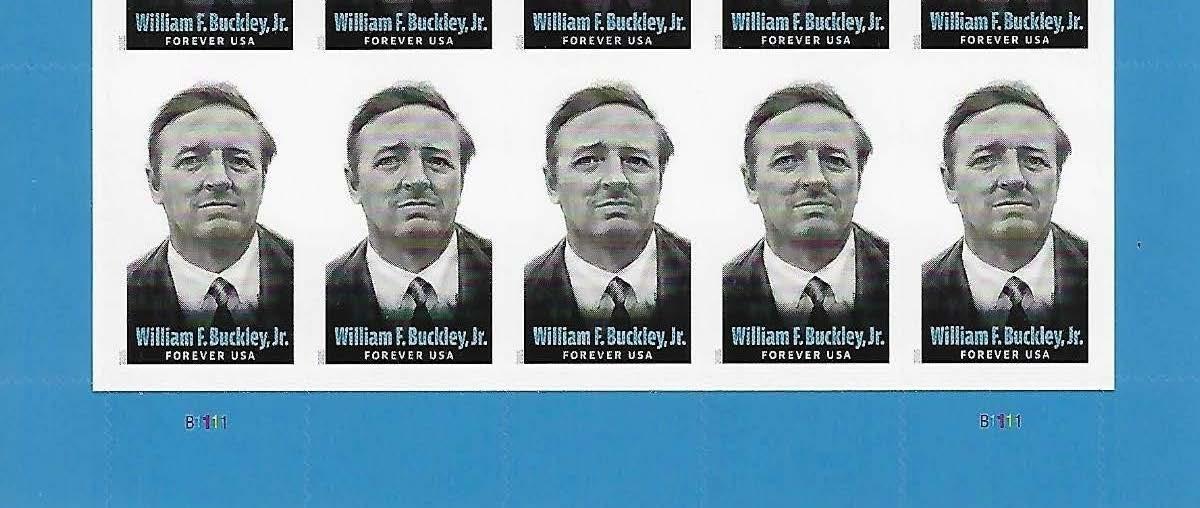
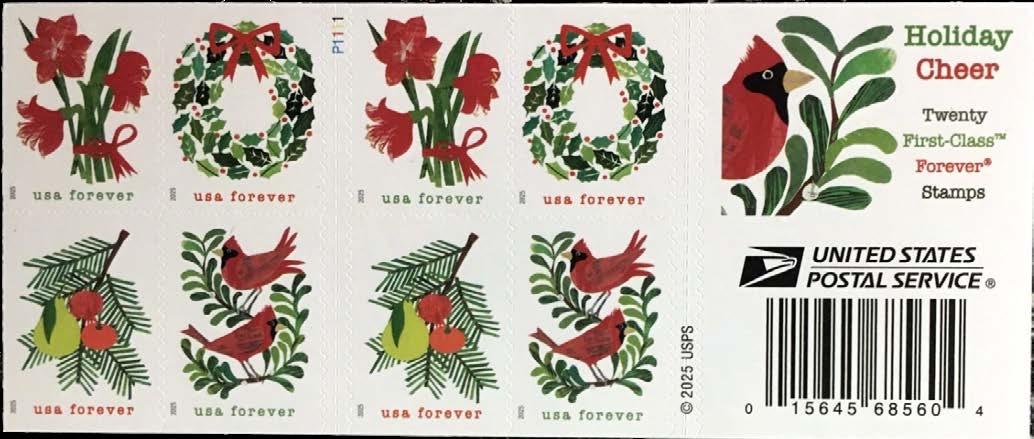

3


3 #???? Winter Landscapes Booklet B1111
COORDINATORS: Members are invited to report their findings to the appropriate coordinator.
All issues through 1980
Sheet stamps after 1980
Kim D. Johnson
310 E N 3rd Street
Georgetown, IL 61846
Jim Cochrane P.O. Box 2009
Great Bend, KS 67530
Coil stamps after 1980 Jill Ambrose PO Box 54622 Cincinnati, OH 45254
Booklet stamps after 1980 Michael O. Perry P.O. Box 1194 Rainier, OR 97048
This monthly report is used to update the Durland Standard Plate Number Catalog.
Classified Advertising
USSS MEMBERS are entitled to two free ads of up to 40 words each year. Other ads are 10¢ a word, payable in advance. For 6 insertions, take a 5% discount; for 12 insertions, take a 10% discount. Ads with [1149] at the end expire with this issue. Make checks payable to USSS. Send copy and check to The United States Specialist, 9038 E. 25th Dr., Denver CO 80238. Free member ads may be emailed to: editor@usstamps.org. Emailing ads saves substantial time for you and the Editor and avoids errors .
WANTED
BUYING IMPERF FARLEYS with GUM. ALL offers welcome! Frank P Geiger Senior - APS Life since 1968 and ASDA since 1974. Phone: 787-6896879–FrankPGeigerSr@gmail.com–PO Box 3442–Pinehurst, NC 28374. [1150]
WANTED—PAYING TOP DOLLAR FOR C-13, C-14 and C-15 singles, both mint/used. Also interested in multiples, flight covers, Zeppelin-related posters, advertisements, etc. Graf Zeppelin specialist. Rob Lehmann email: diecasttoys@yahoo.com or call: 240422-0118. [1150]
WANTED TO PURCHASE #1053 HAMILTON $5 Commercial Usages. Especially need use to foreign destination. Also doing a survey so scans appreciated. Doug Weisz weiszcovers@gmail.com, 773-9144332. 33 W Ontario St. #48A Chicago IL 60654. www.douglasweisz.com [1152]
SEEKING USS INDEPENDENCE STAMP similar to Scott #4703 USS Constitution stamp. Bernard Wojnowski; 64 Mariner Rd., Vineyard Haven, MA 02568. [1155]
WANTED: SPECIAL BOOKLET PAPER PLATE blocks numbers 566a, 567b, 568a, 569a, and E13a need to have been certified. Send price picture of plate block and certificate to whs1963whs@yahoo.com [1149]
WANTED - NAMW TEXAS POSTMARKED covers. Member APS, IPDA, USSS, APNSS. Email: htputney@ gmail.com [1162]
FOR SALE
IF MY STAMPS ARE NOT VF/XF, SUPERB, I sell in packets. upgrade now at low prices. U.S.A. and Norway with no faults, centered and clean. Request list—Reed Roholt, P.O. Box 1006, Beaver, UT 84713. Satisfaction guaranteed. [1160]

The U.S. Philatelic Classics Society is a not-for-profit collector organization exclusively devoted to 19th century United States stamps and postal history. Our quarterly Chronicle is widely recognized for presenting new scholarship and discoveries. For membership information and much more, find us at:
www.uspcs.org.
Index of Advertisers
Armen Hovsepian (www.USatFACE.com).........................................524 Boston 2026 (www.boston2026.org) ....................................... 503 Mountainside Stamps, Coins and Currency (www.mountainsidestampsandcoins.com) 524
Precancel Stamp Society (www.precancels.com)......................................... 496 Richard Friedberg (www.friedbergstamps.com). 502
Robert A. Siegel Auction Galleries (www.siegelauctions.com) 483
Scott A. Shaulis (www.shaulisstamps.com) ...................................524
U.S. Philatelic Classics Society (www.uspcs.org) 528
United States Stamp Society (www.usstamps.org) 523, 524, Covers
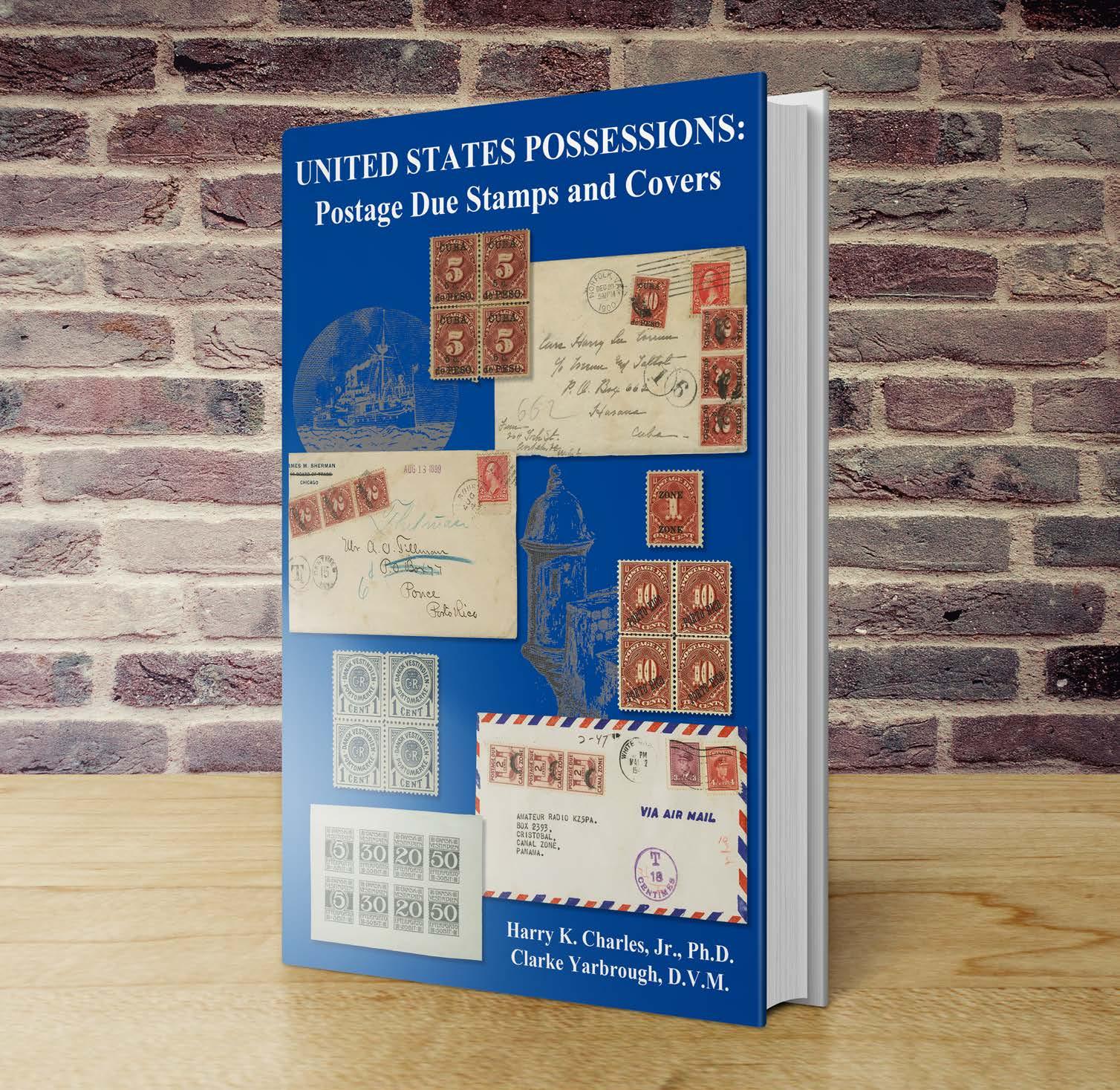
United States Possessions: Postage Due Stamps and Covers presents the story of Postage Due stamps used in the major possessions or territories of the United States. Written from a stamp collector’s perspective, the authors address the challenge of identifying the myriad of Possession Postage Due stamps by concentrating on stamp identification while also covering the Postage Due issues of Cuba, the Danish West Indies, Puerto Rico, the Panama Canal Zone, the Philippines and more.
In addition to the text, the monograph contains over 300 illustrations and five appendices which provide information to supplement and further explain key points. In many cases, the information presented is new or, if previously reported, organized in a new manner to help the reader understand the complexity of the Possession Postage Dues.

United States Possessions: Postage Due Stamps and Covers
Hard cover, 352 pages, 6-in × 9-in.
Member Price: $39 US postpaid Non-Member Price: $43 US postpaid Purchased online at: www.usstamps.org/store/ or by mail to: Executive Secretary, P.O. Box 1602, Hockessin, DE 19707-5602


United States Stamp Society
The 2020 edition the Durland Standard Plate Number Catalog provides the most comprehensive research source for plate number information on United States postage and revenue stamps, including tax-paid revenue stamps, with listings for overprinted Possessions postage, Allied Military government stamps and other back-of-the-book stamps, dummy and test stamps, MDI "Blue Cover" booklets and partial plate numbers on booklet and coil stamps.
2020 Edition of the Durland Standard Plate Number Catalog 448 pages available in Spiral Bound format.
Member Price: $40 US plus shipping Non-Member Price: $45 US plus shipping
Order Online at: www.usstamps.org/store
